Indian Accent has long been touted as one of India’s best restaurants, and during a recent trip to New Delhi, I simply had to try it for myself. I was particularly excited to dine here, as prior to this visit, I’d never had a fine dining experience based around Indian cuisine before.
When the opportunity to take a trip to India to visit my family presented itself, I swiftly secured my reservation at Indian Accent, and eagerly awaited the experience from that point forward.
In This Post
- About the Restaurant
- About the Chef
- Booking
- Location
- Dinner Experience
- Wine Pairings
- Service
- Conclusion
Indian Accent – About the Restaurant
The prestige that surrounds Indian Accent is well deserved, as it puts an inventive spin on Indian cuisine by elevating traditional flavours with an array of techniques and ingredients from around the globe.
Indian Accent has received a number of accolades in recent years, having been awarded the title of the “San Pellegrino Best Restaurant in India” by Asia’s 50 Best Restaurants for seven years in a row and ranked as the “Number 1 Restaurant in India” by Condé Nast Traveller. Other accolades include recognition from Times Magazine, who noted Indian Accent as being “Amongst the World’s 100 Greatest Places”.
Fortunately, you don’t need to fly halfway across the globe to dine at this prestigious restaurant, as there’s also a location in New York City.
Indian Accent – About the Chef
Behind the menu, Chef Manish Mehrotra is highly revered and critically acclaimed in his craft.
Considered the pioneer of inventive Indian cuisine, he is treasured amongst the most exciting chefs in the world, most notably for his modern take on Indian food in a refined and elegant setting.
He began his career in Mumbai, joining Ananda Solomon’s team at the Thai Pavilion with Taj Hotels. In 2000, Chef Mehrotra joined Old World Hospitality, where he has remained for the last 22 years.
Chef Mehrotra’s menu is a contemporary twist on Indian cuisine, incorporating seasonal produce melded together with unusual ingredients from around the world. The presentations come with an exciting and adventurous flair, one that delivers traditional flavours with a hint of something new, something unexpected, and something truly delightful.
Indian Accent – Booking
Reservations can be made by calling or emailing the venue, and there is a 1,000 INR ($17 CAD) per person deposit that is paid at the time of booking.
Indian Accent – Location
You’ll find the New Delhi location of Indian Accent at The Lodhi Hotel, a property which is part of the American Express Fine Hotels & Resorts program.
From the outside, you’ll head up a small set of stairs into a reception area.
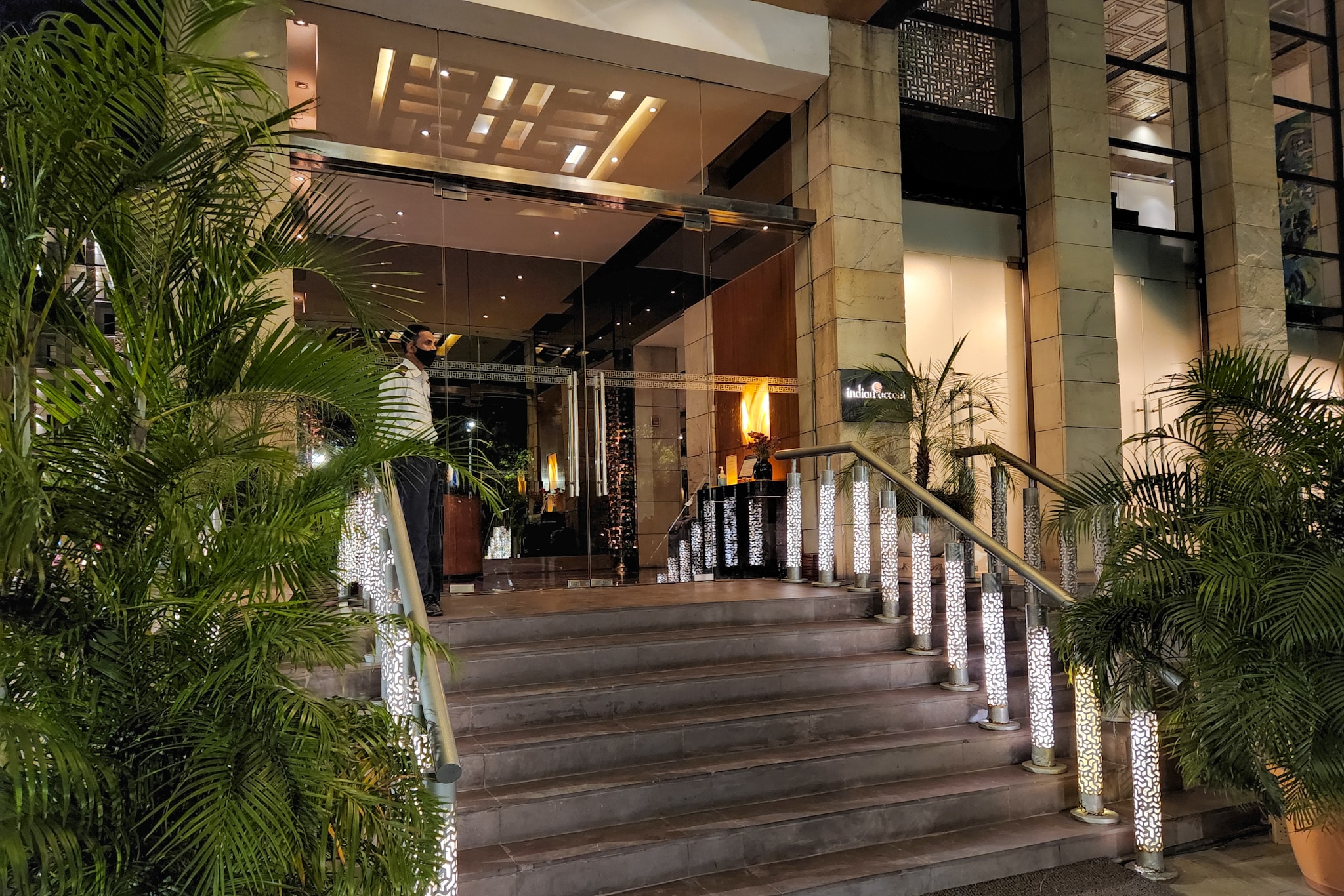
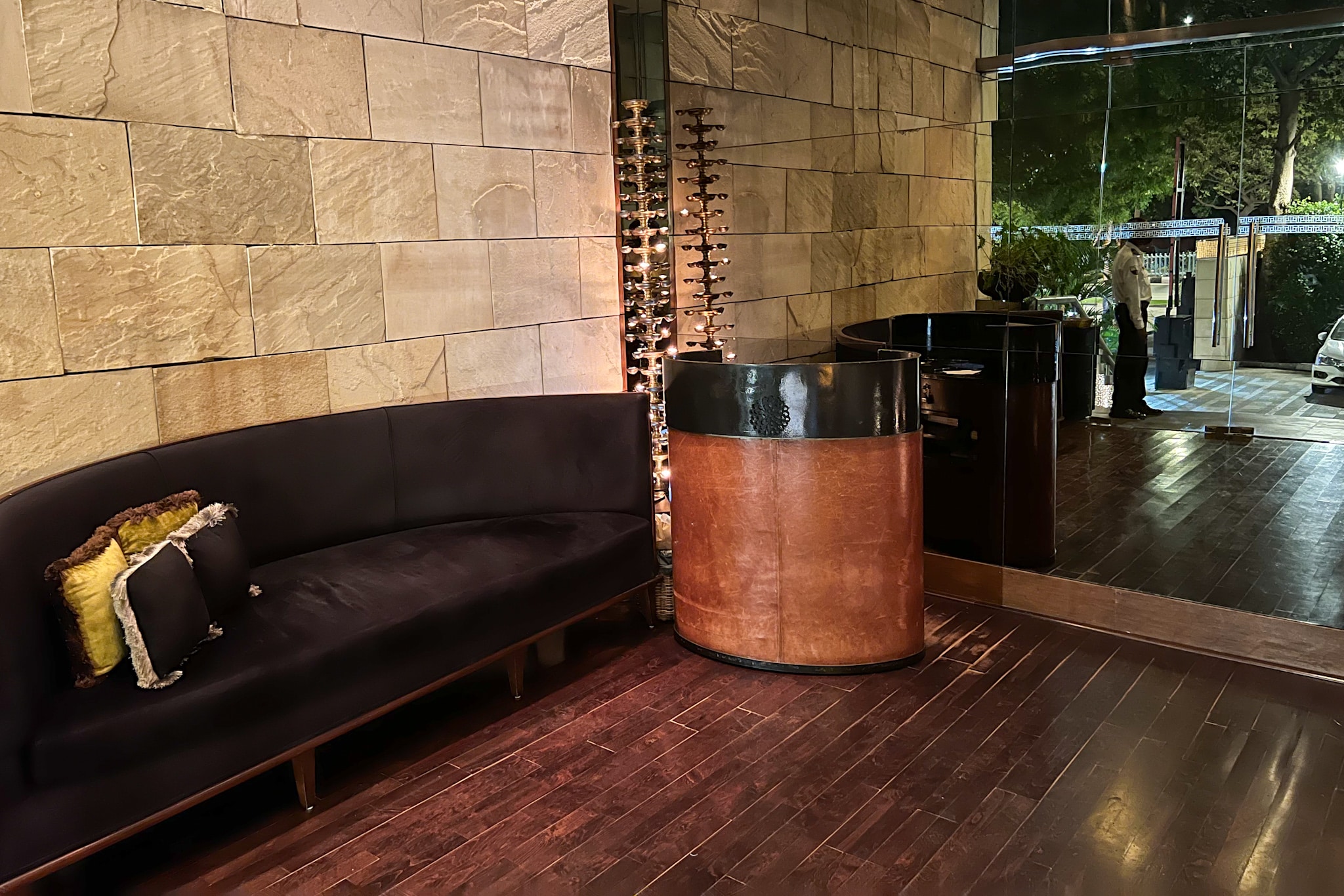
The space then opens up into a lounge, where there are a number of comfortable seating arrangements dotted around some statues. You’ll also find more seating and a private dining space upstairs.
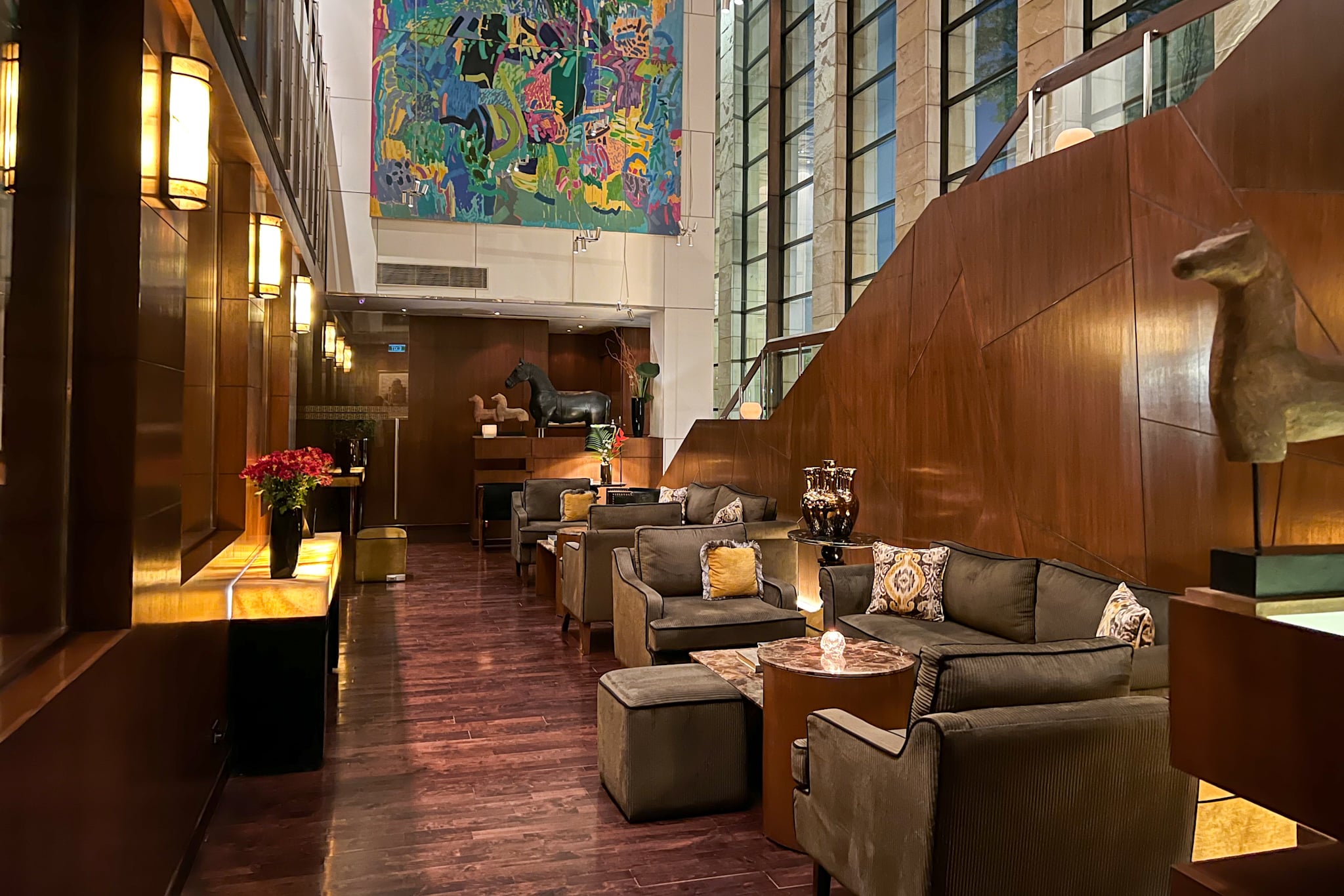
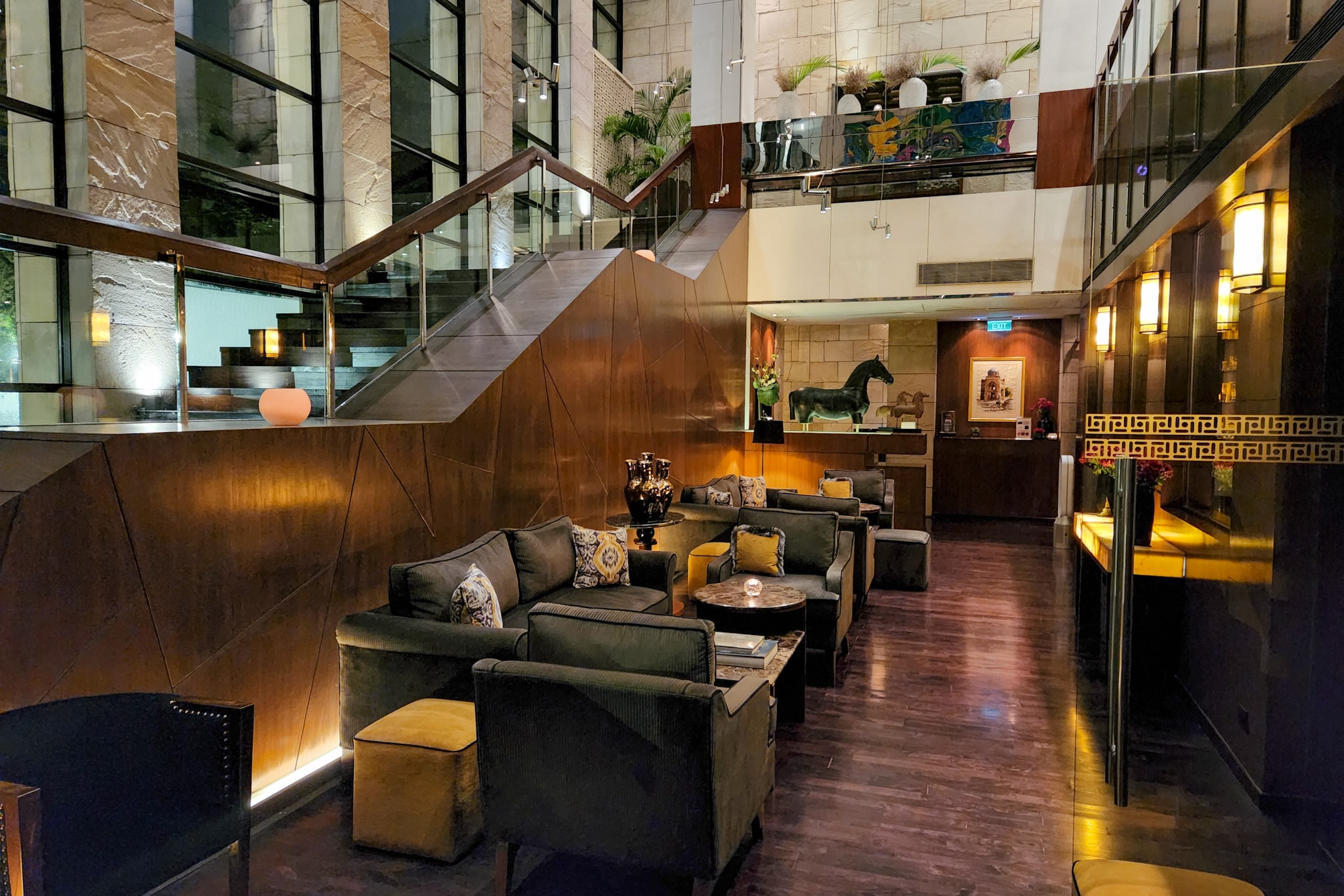

Inside, the bar glows with warm lighting and wood accents that are further expanded in the body of the restaurant. It has a modern look, with sleek lines deepened by the wooden walls and floors, as well as stone accents.
The bar is located in the main dining area, and then the restaurant further expands into two narrow dining areas with an outdoor water feature in between them.
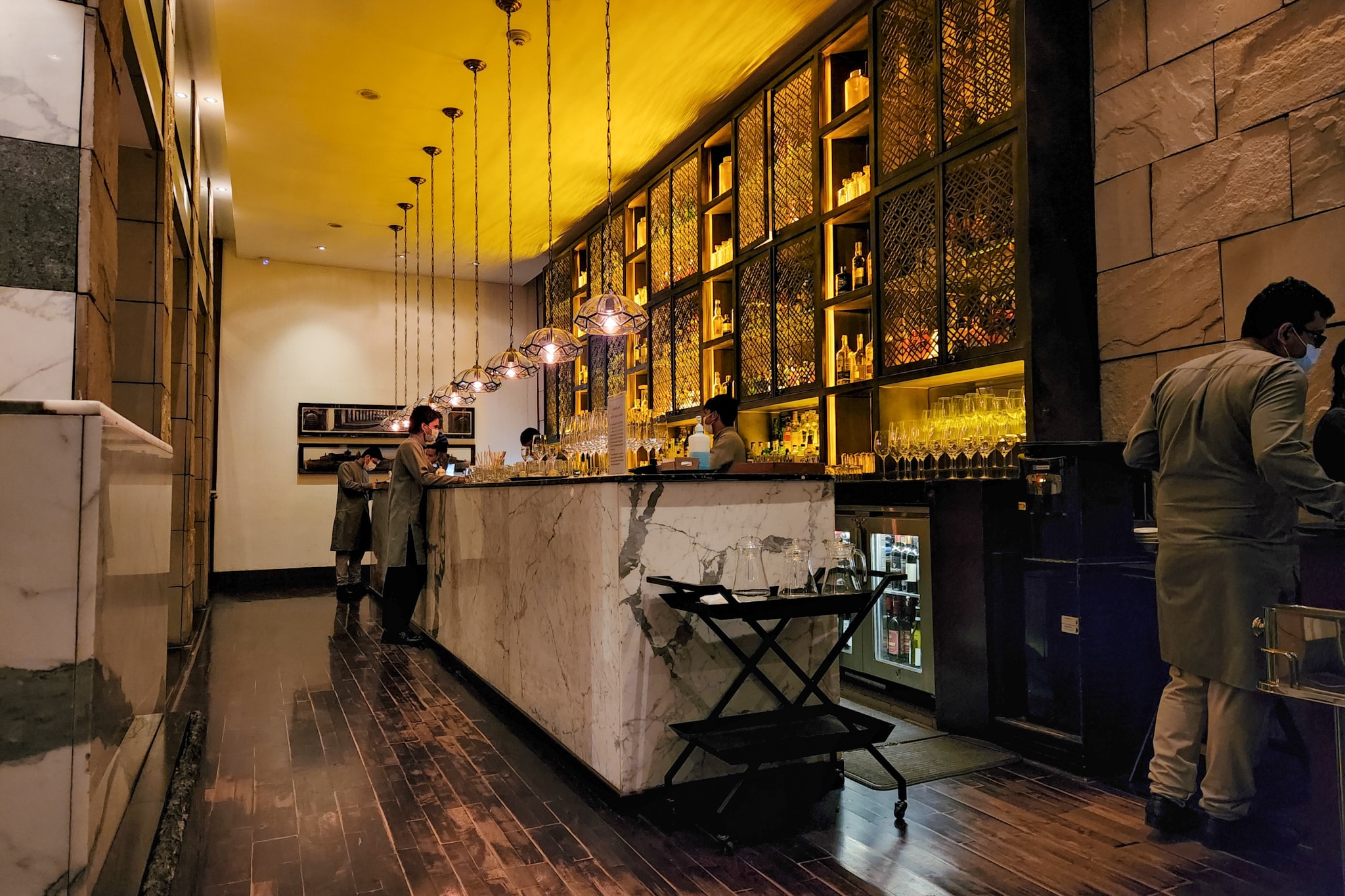
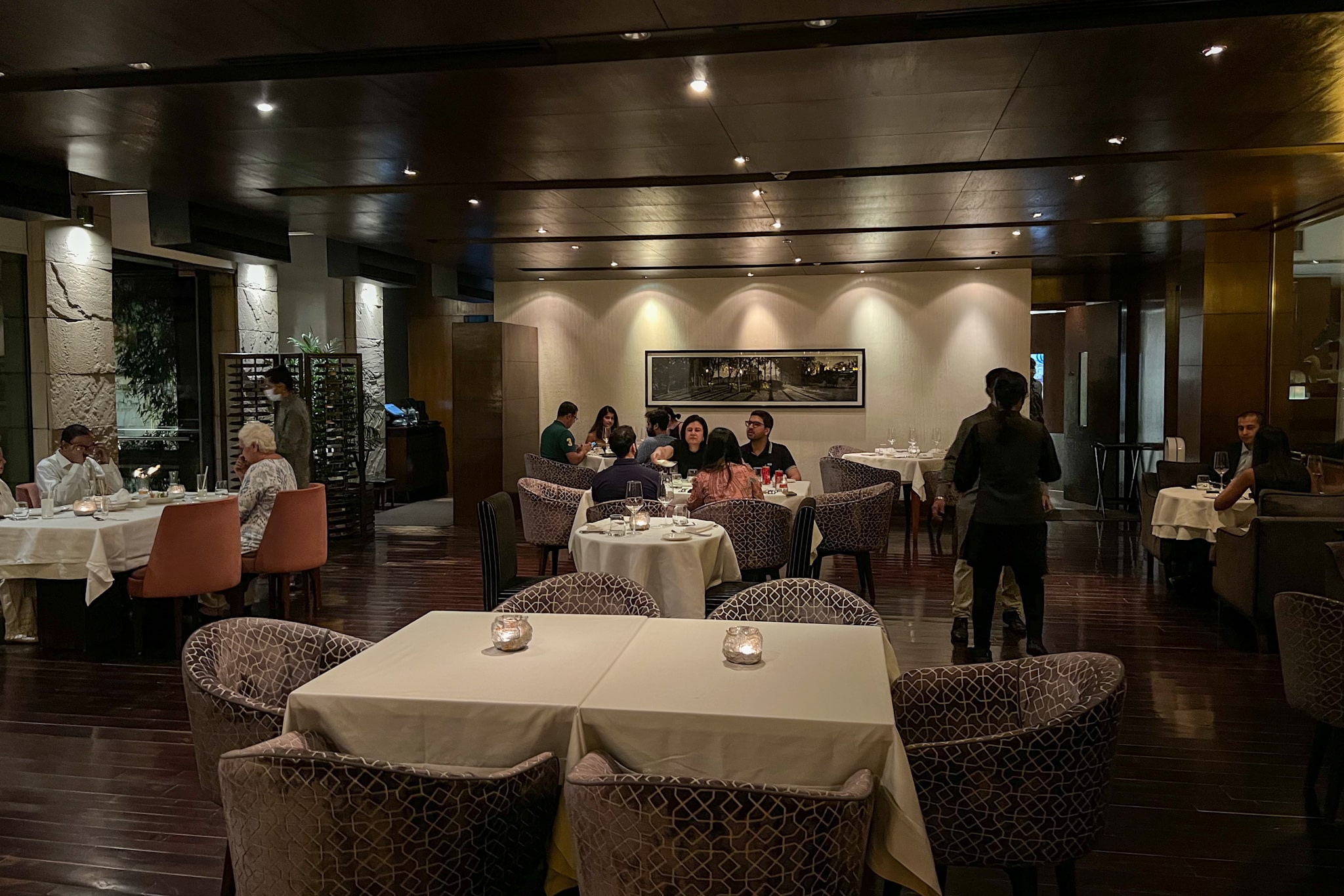
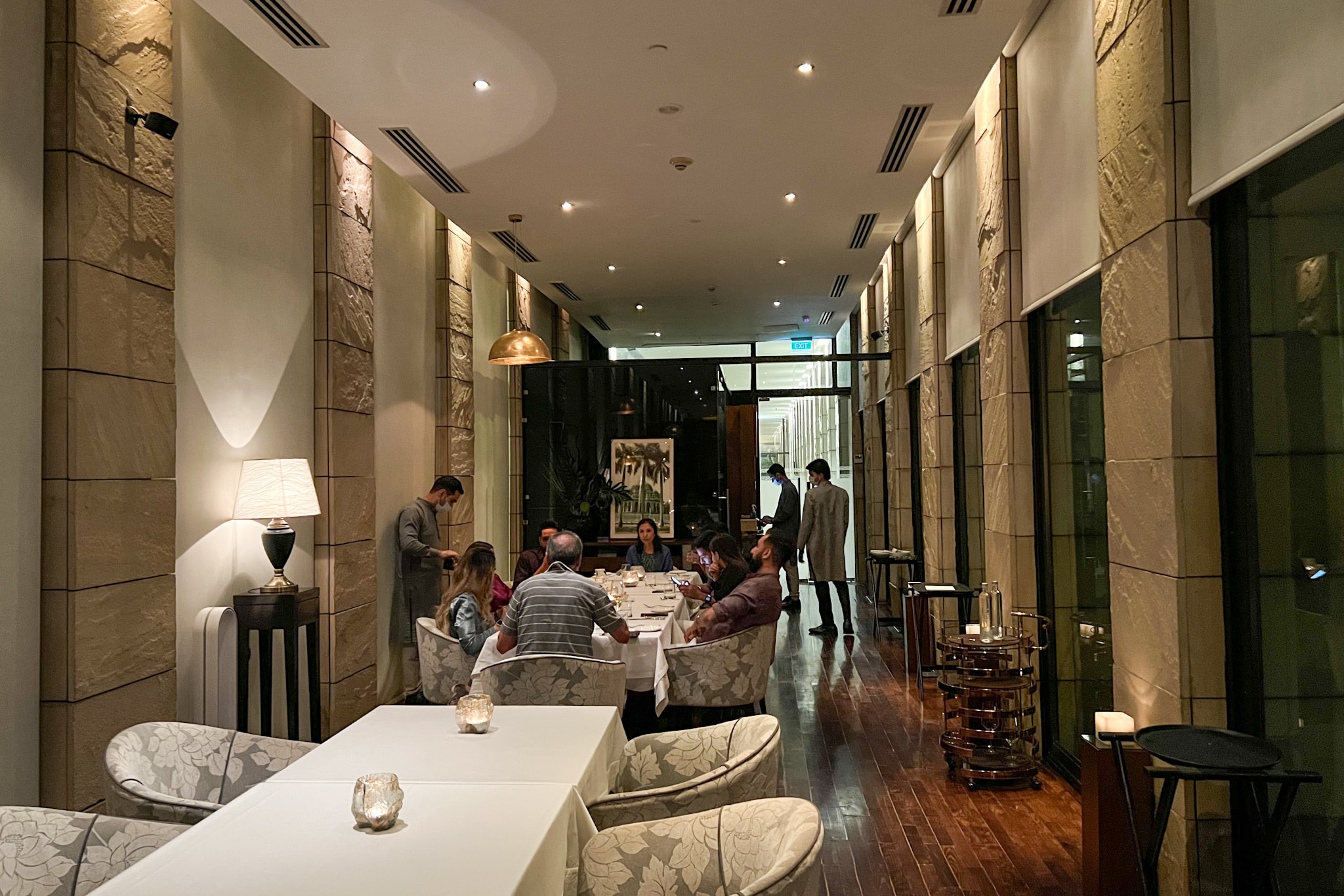
Seating is elegant, yet comfortable with regal-looking cushioned armchairs to make you feel like royalty.

When making your reservations, inquire about having a table by a window, so you can gaze out at the water feature flanked by fiery torches for a nice view. This is where we were seated for our dinner, and it added to the warm ambience in the restaurant.

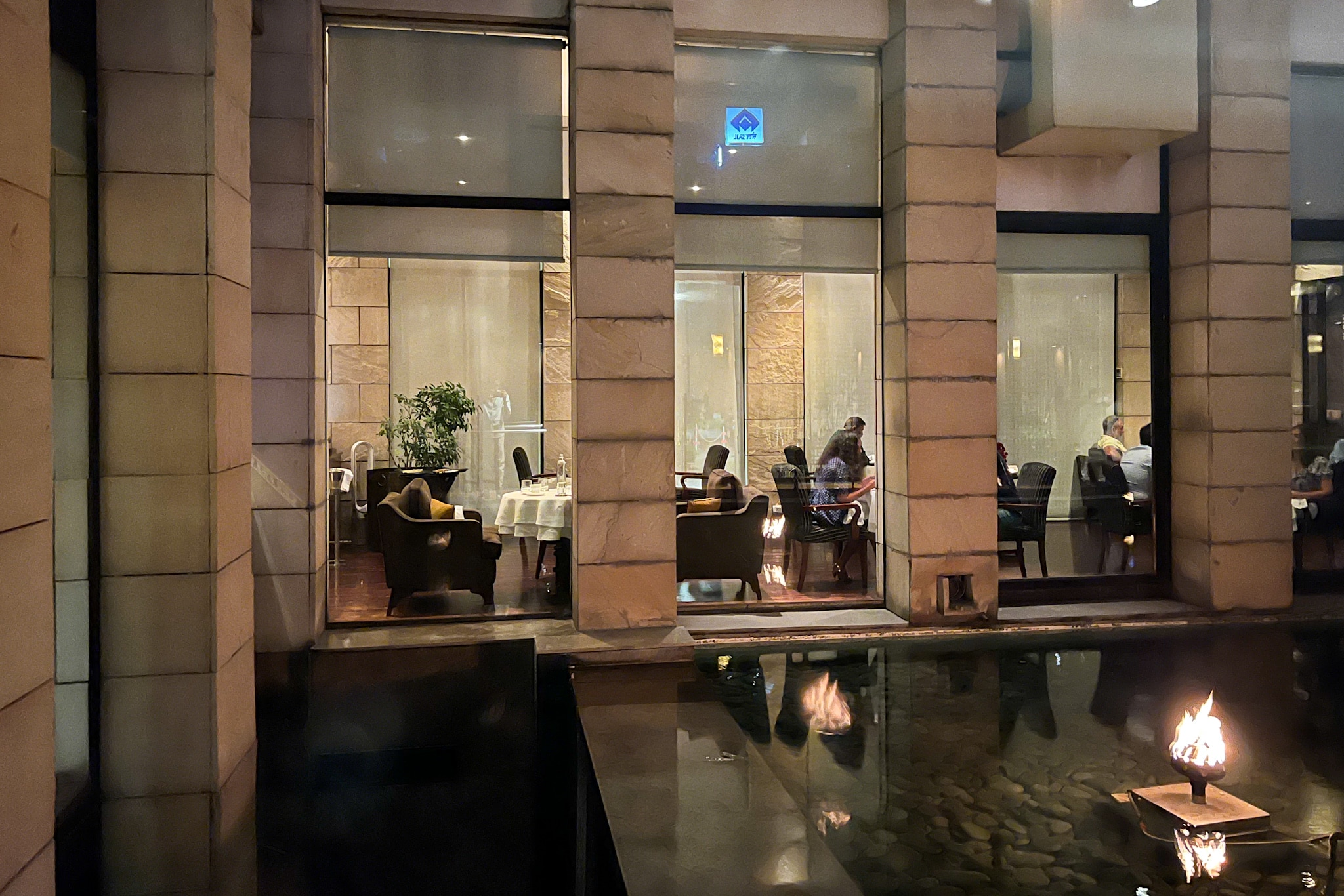
There’s also a private dining area accessed through a hallway with tall glass panes and wooden floors.
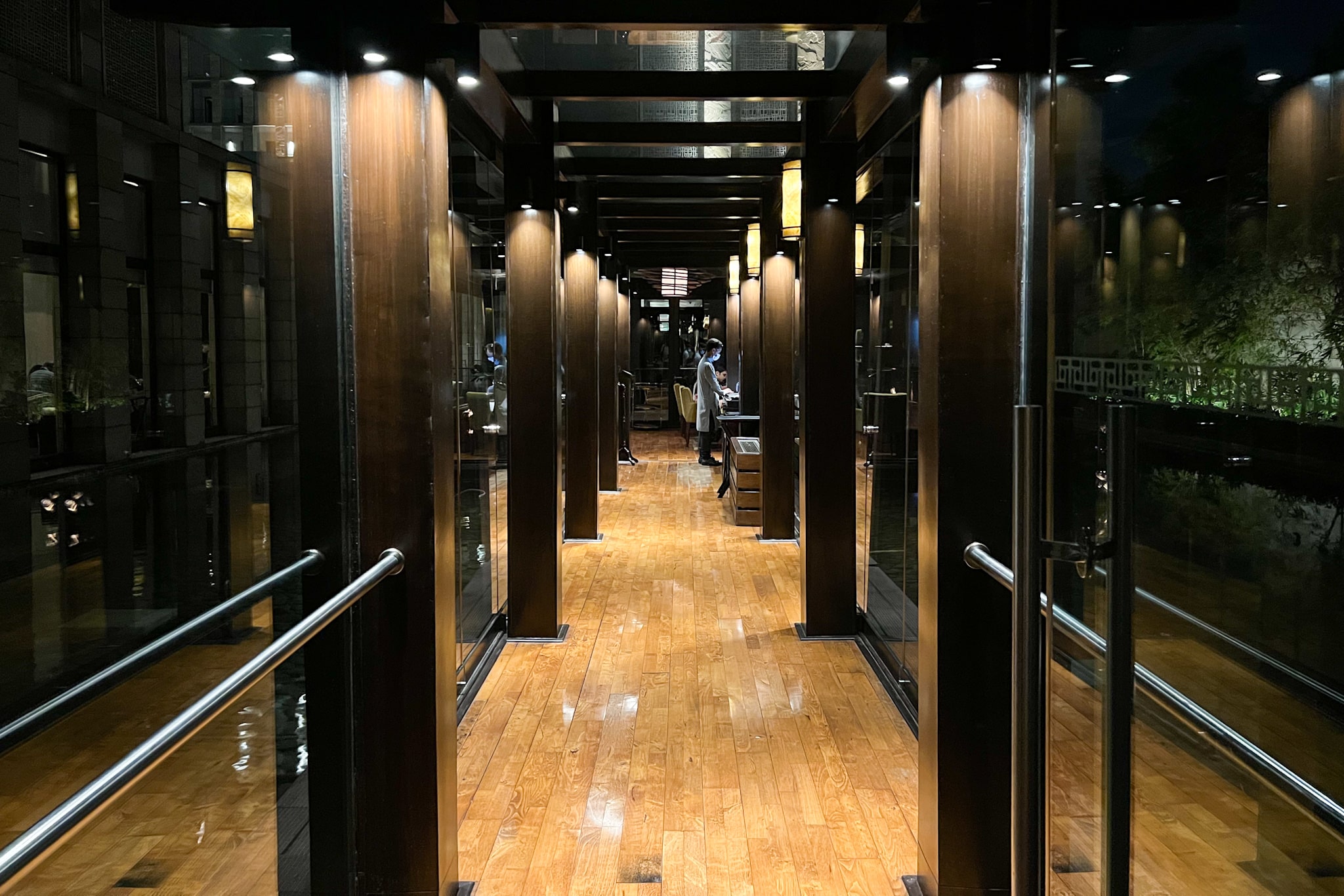
Indian Accent – Dinner Experience
There are several menus for Indian Accent, including an à la carte menu available for lunch and dinner, with prices that range from 650–1,750 INR ($11–29 CAD), as well as a four-course express tasting menu for 3,300 INR ($55 CAD) per person.
You also have the option of the chef’s tasting menu, which is what we selected during our visit. Indian Accent offers a vegetarian version for 4,350 INR ($72 CAD) per person or a non-vegetarian tasting menu for 4,450 INR ($74 CAD) per person.
If you select either of the chef’s tasting menus, you can enhance the experience with a pairing of six half glasses of wine for an additional 4,300 INR ($71 CAD) per person.
While the cost of the chef’s tasting menu may be quite a bit higher than many restaurants in New Delhi, it’s relatively affordable when compared to similar dining experiences in other major cities around the world.
1. Amuse Bouche
The meal began with three delightful miniature naans lightly filled with blue cheese. It seems an unlikely combination, but we loved the duo of fresh, fluffy-textured naan with melted blue cheese.
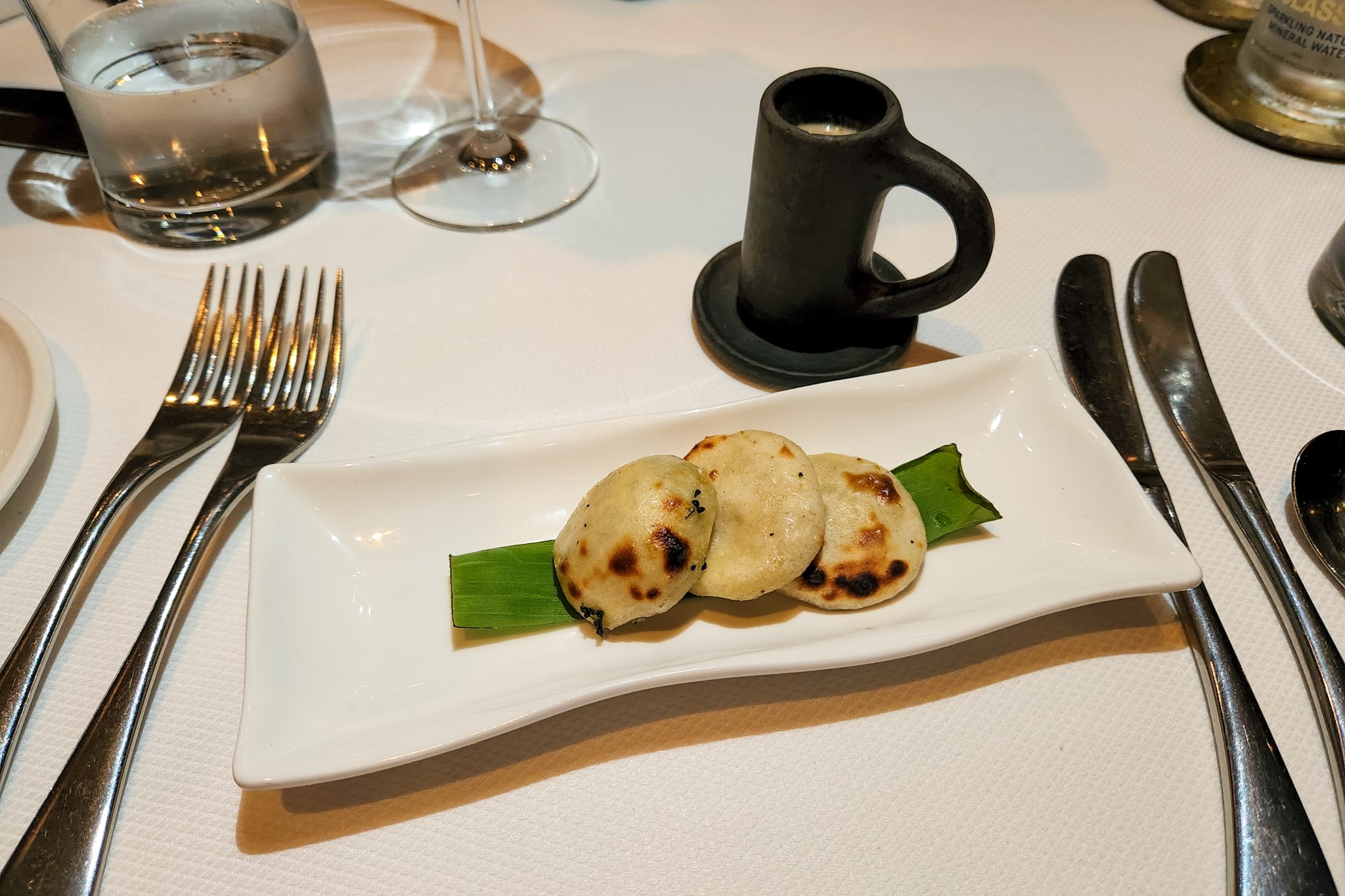
It was strong and flavourful, working well in the same way that the strong taste of garlic and naan go together nicely.
2. First Course – Street Food
The presentation of the first course was fascinating to me. Chef Mehrotra cleverly turned common street foods into a luxury experience, and I thought it was very cool, to say the least.
In this serving, we had sindhi dal pakwan, herb goat cheese vada pao, quinoa dahi bhalla, chutney aloo, and gol gappa with five waters.
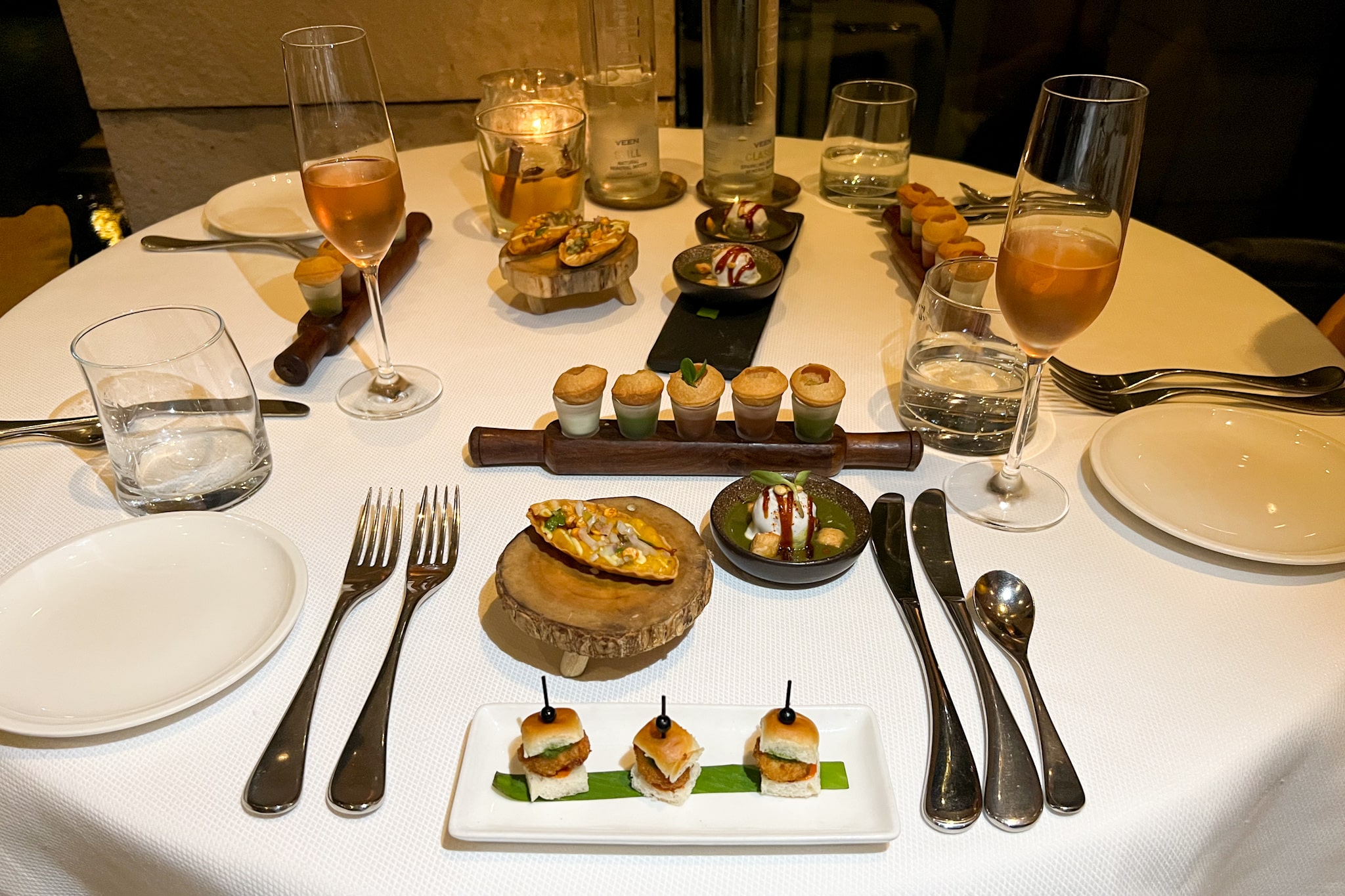
As we gazed out at this course, I found myself most looking forward to the gol gappa (also known as pani puri), as it has been a favourite snack of mine since I was a child.
The chutney had a silky and smooth texture with a bounty of flavour, while the five waters consisted of pani puri mint, imli, pomegranate, pineapple, and buttermilk garlic.
I think this would be a great dish for those with a palate unfamiliar to Indian cuisine; however, since it lacked the punchy, pungent, spicy flavours that I find most appealing about the waters, I think I’ll stick to the street vendors for this dish moving forward.
The dahi bhalla was my favourite of the first four starters. Crunchy quinoa fritters (bhalla, but traditionally made with lentils) topped with yoghurt (dahi) along with an assortment of spices and sweet and tangy chutneys, as well as boiled chickpeas and potatoes, gave this traditional street food a dynamic range of textures and flavours.
The pairing for this course was a NV Chandon Brut Rosé, something bubbly to start this festive occasion. Note that this is a wine sourced from India, and shared very little semblance to the Moët & Chandon brand that you may otherwise be familiar with.
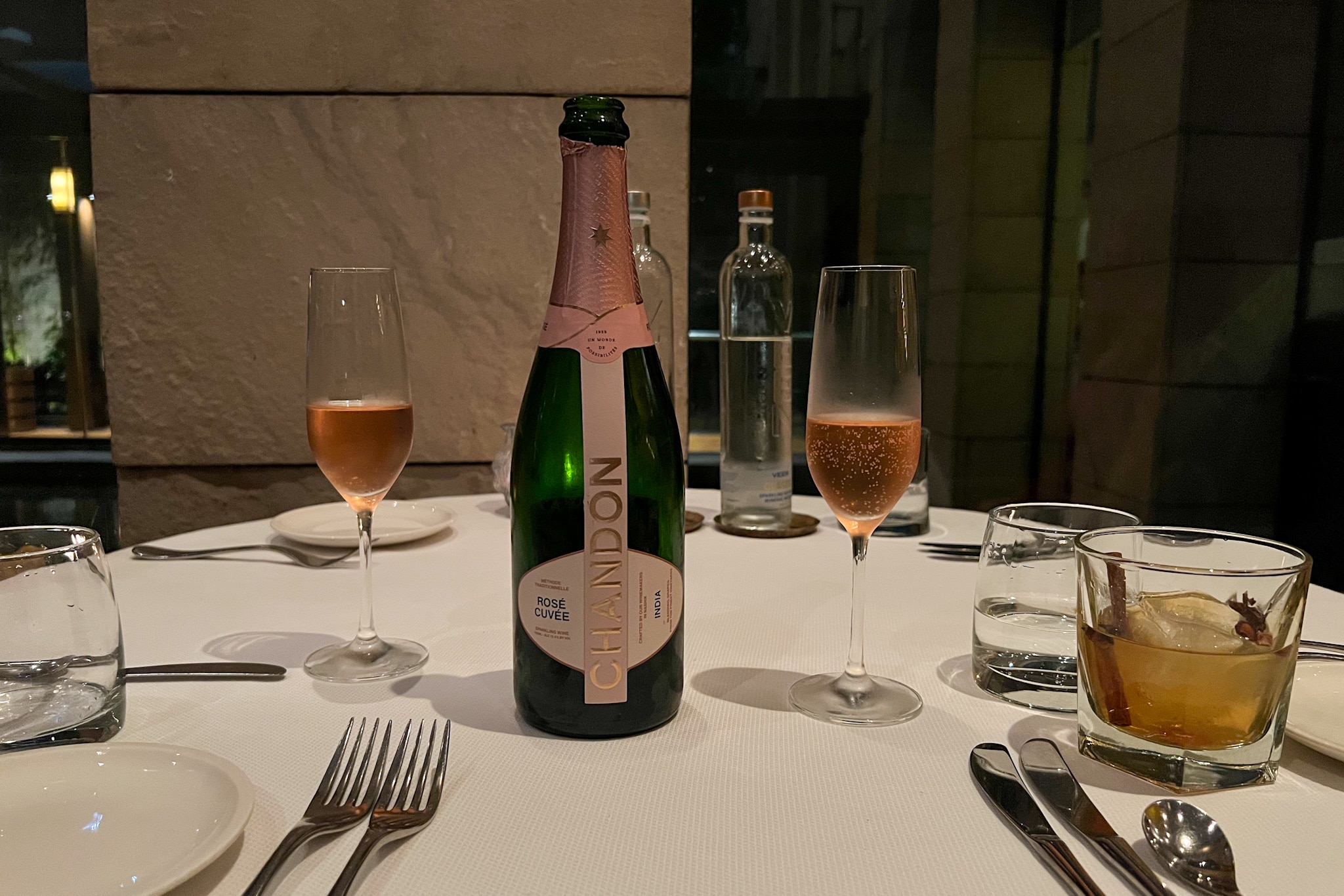
3. Second Course – Chicken Seekh Kebab
Next to grace our palates was the chicken seekh with a beurre blanc sauce and pickled vegetables, paired with a Brancott Estate Sauvignon Blanc to drink.
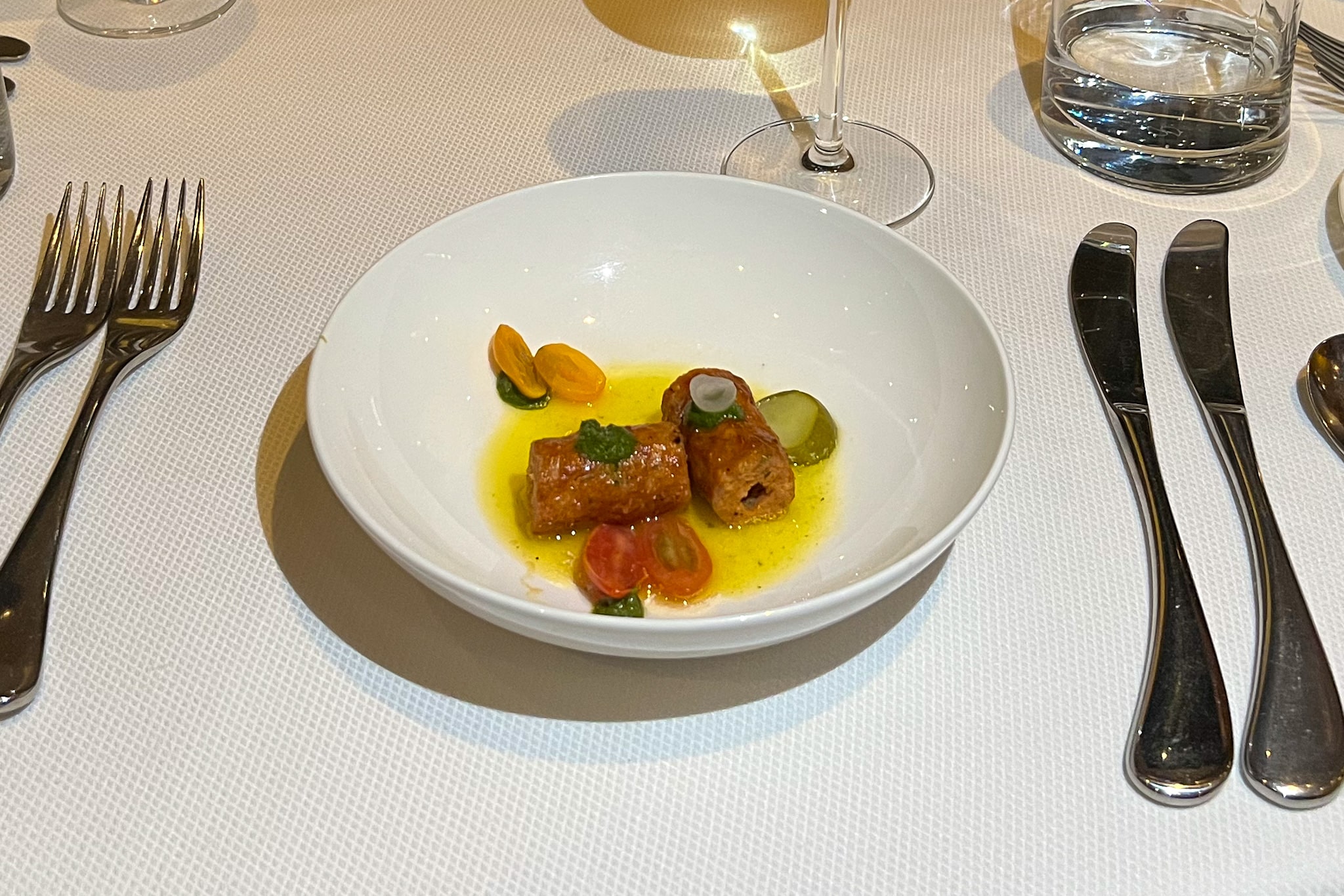
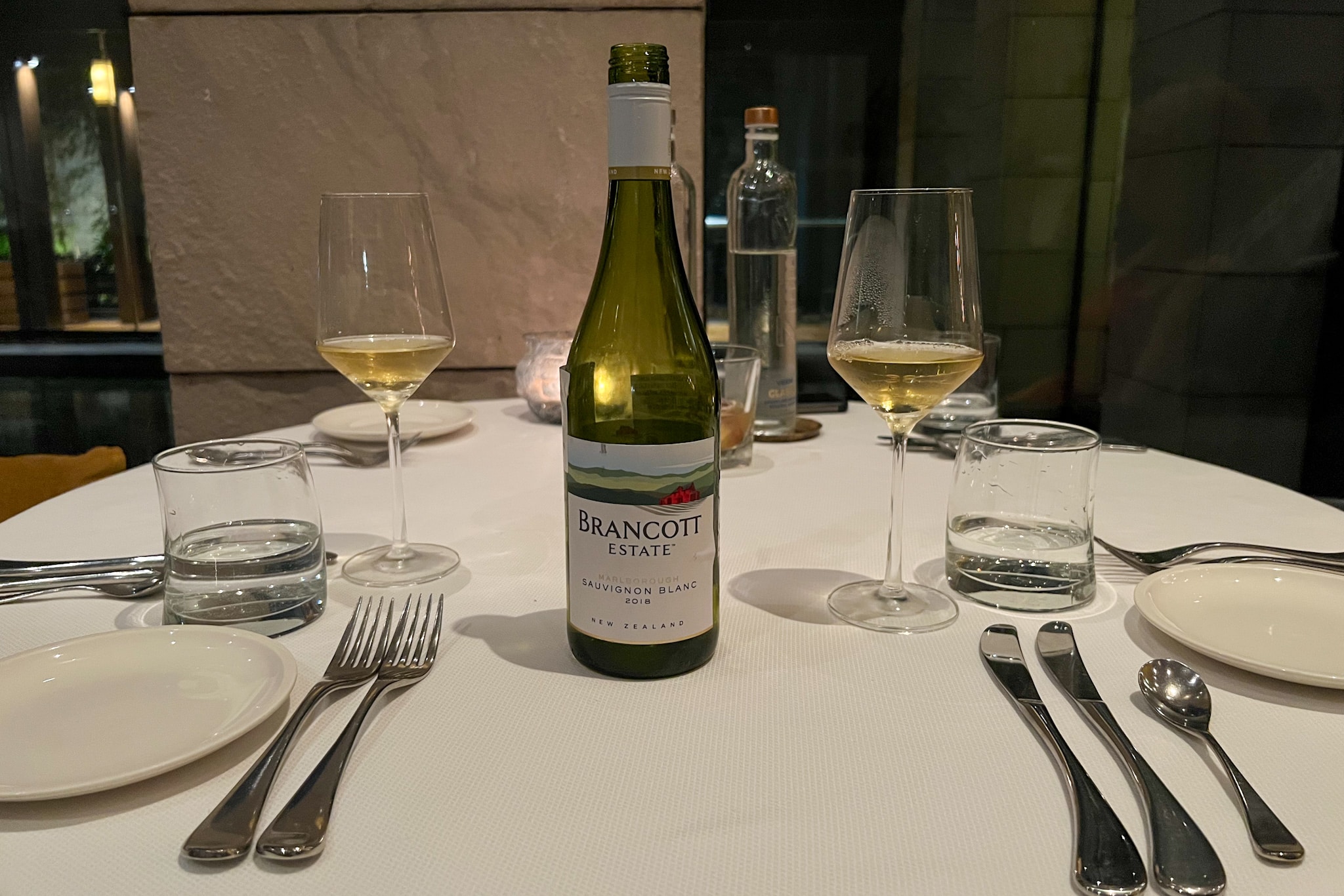
The minced chicken kebab was tender and generously seasoned with the butter sauce, creating a melting sensation in my mouth that was truly spectacular. In lieu of the raw onions that are traditionally served, the chef opted to serve pickled vegetables instead, which I thought was a nice French touch to a classic Indian kebab dish.
4. Third Course – Bihari Taash
Our third course, bihari taash, was served with a bold and spicy Spanish wine, the 2020 Sangre de Tora from Catalonia.
Bihari kebaps are more commonly found in the east of India and Nepal. The marinated mutton dish is not typically found on a Westernized Indian menu, and it was a treat to enjoy this dish.
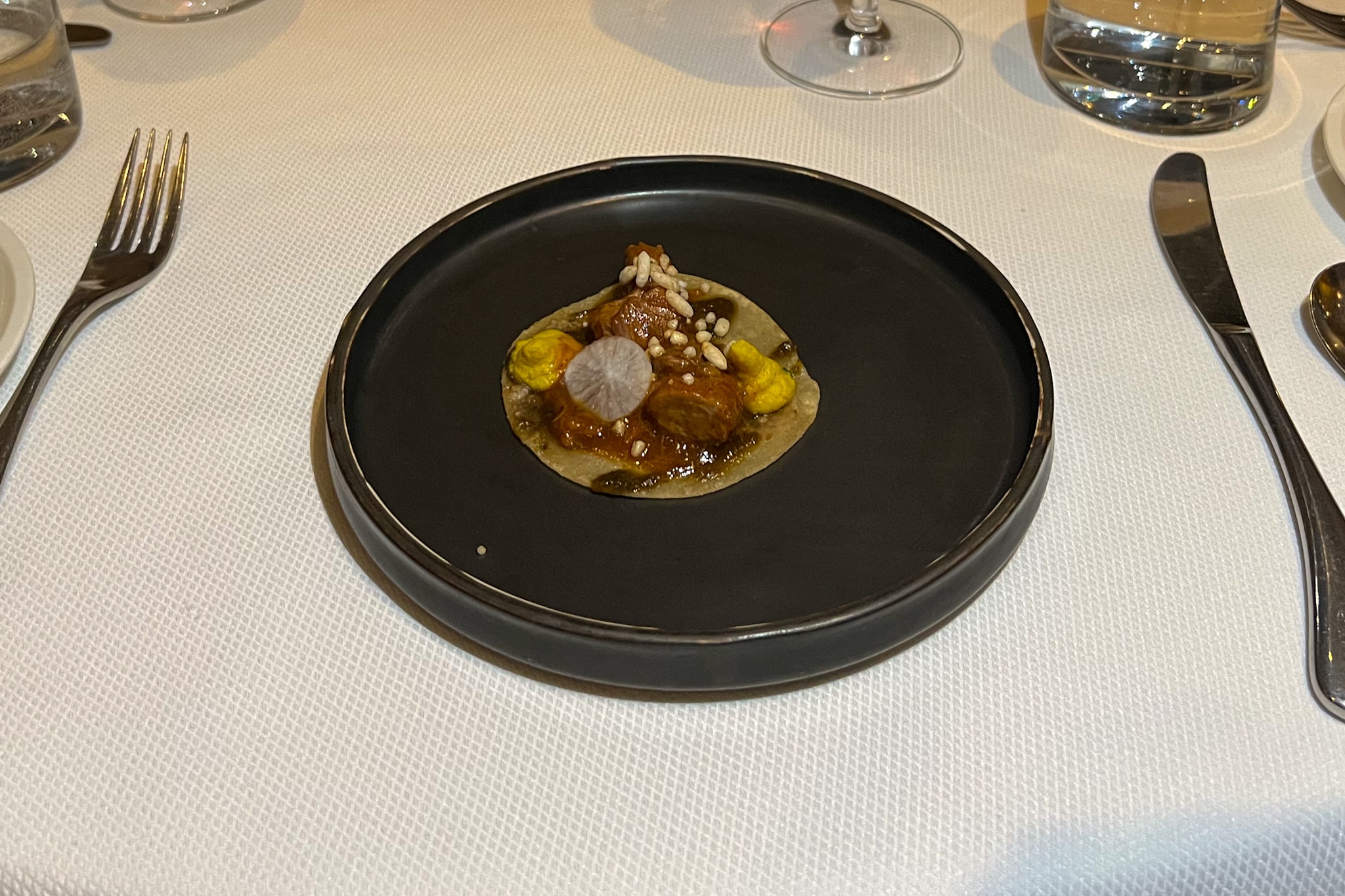

The meal featured mustard oil and Nepali szechuan pepper that gave this a distinctive style of heat, akin to the sensation that wasabi or horseradish would produce. The meat itself was extremely tender, and was served on a roti with a sweet and flavourful sauce that was a splendid match.
5. Fourth Course – Mud Crab and Japanese Rice
Served with a Pinot Grigio from Tuscany, Italy, the next course consisted of mud crab with tomato, Bengali chilli mustard, and sticky rice.
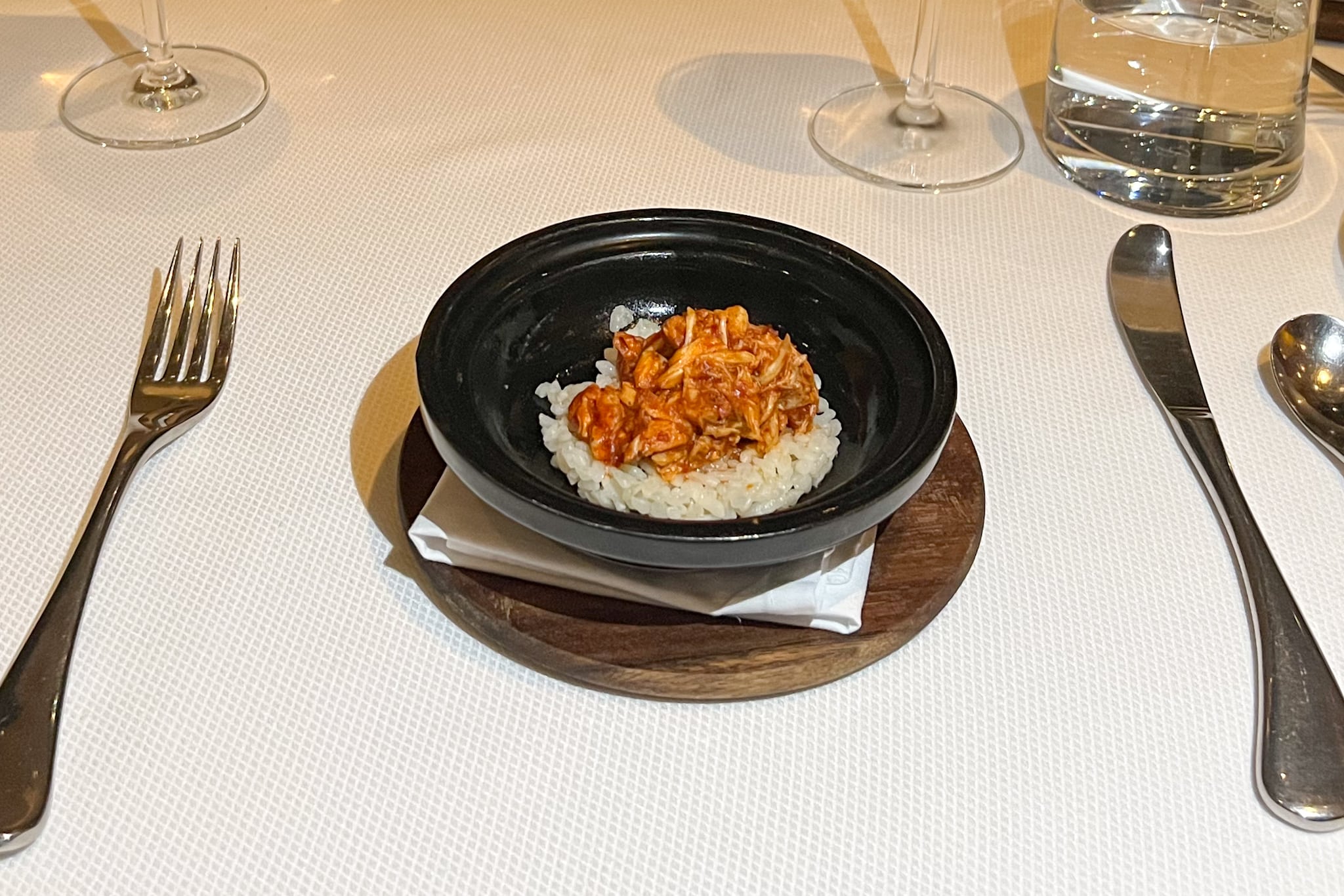
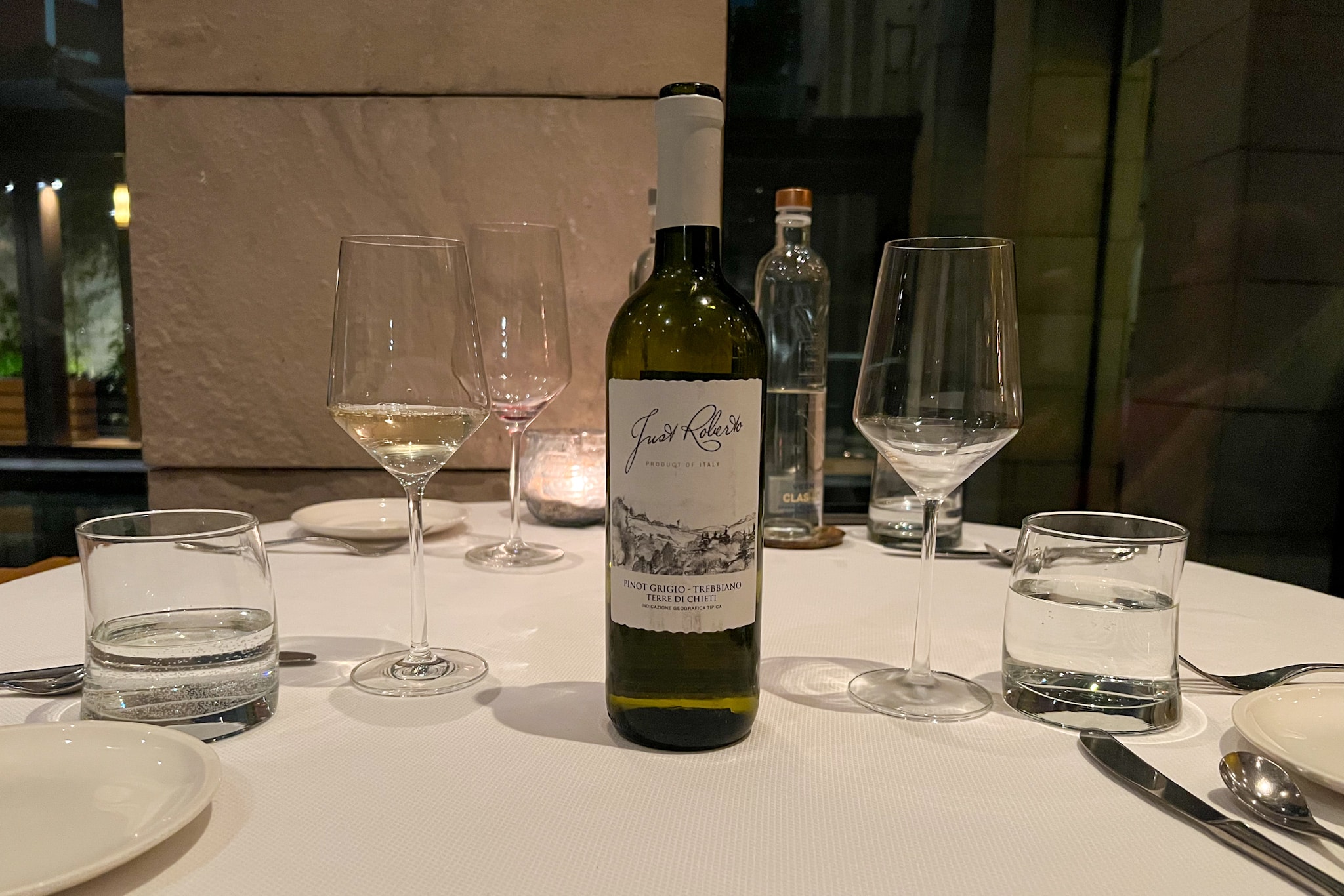
The spicy sauce brought out a beautiful contrast for the sweet crab meat, and was a treat to eat with the sticky rice served beneath it. This course reminded me of all the delicious crab I ate at hawker stands on my last trip to Singapore.
6. Palate Cleanser
To cleanse our palates, we were presented with a kulfi sorbet of pomegranate juice and chaat masala. It was light and refreshing, at least according to my wife Nicole.
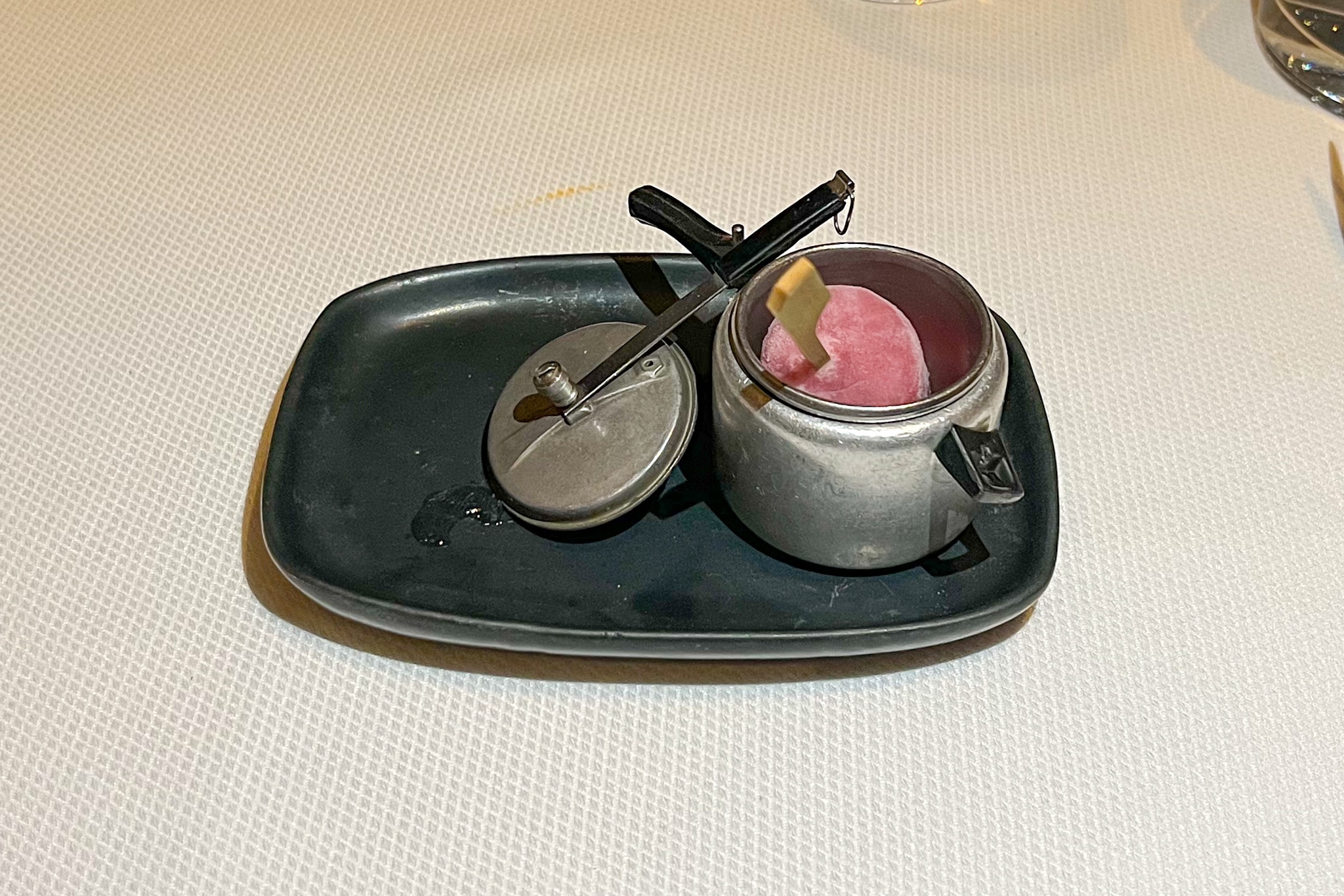
As some of you may know, I’m allergic to fruits and I was unable to enjoy this part of our dinner. In a somewhat unusual fashion, I was not provided with a substitution.
7. Fifth Course – Duck or Fish
For the fifth course, we had a choice of fish plantain masala with duck coconut curry or rawa fish with black dairy dal and caramelized walnut raita.
I opted for the duck, which was presented in a buttermilk chilli curry and accompanied with raita, asparagus, and roasted potatoes. A Bex Riesling was paired with the duck.

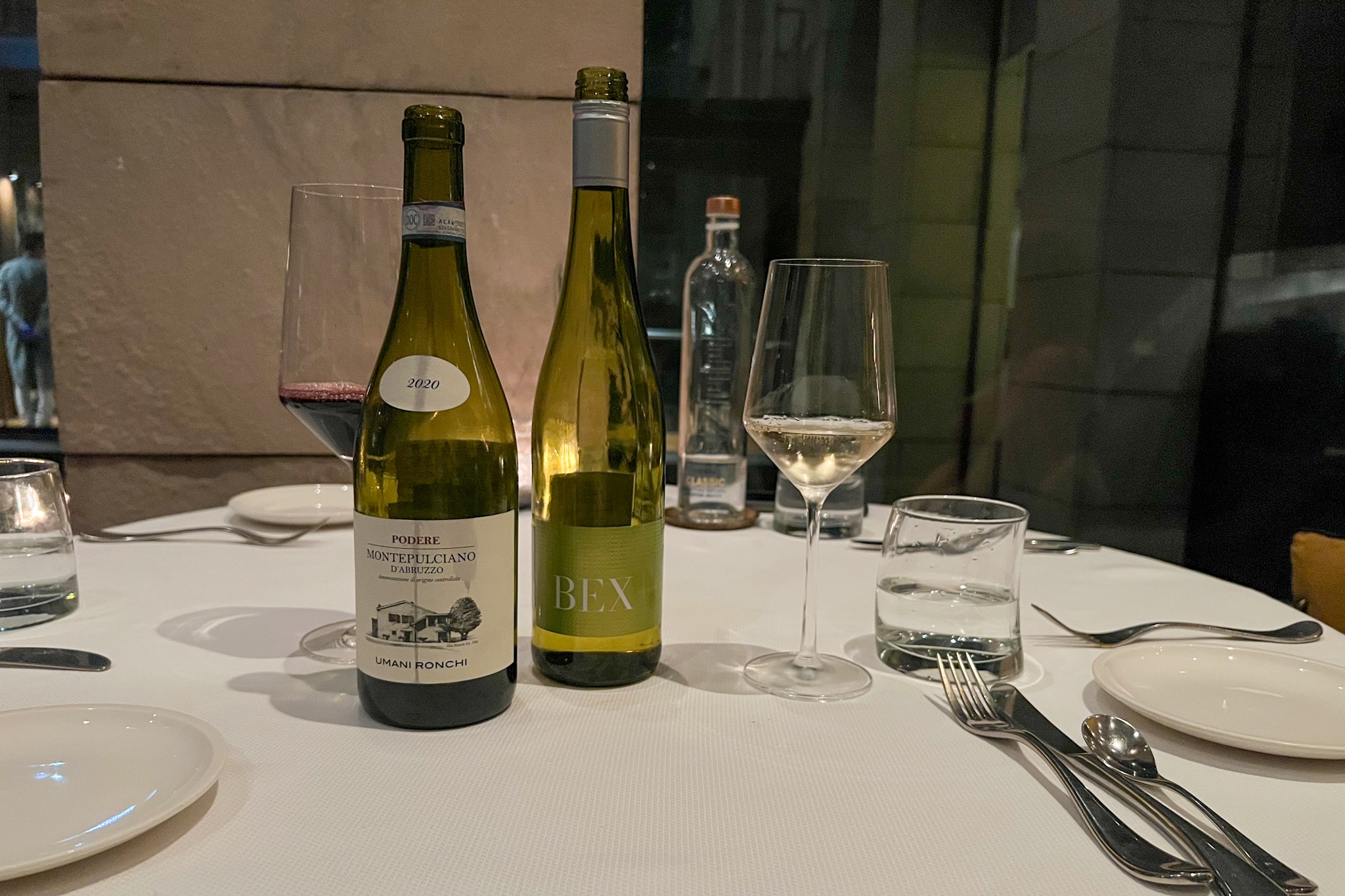
The three-pepper duck was an incredible course. Not only was the presentation wonderful, with the confit duck surrounded by a sea of spectacular coconut curry, but the meat was soft and full of flavour in every bite.
This became both my first time enjoying duck outside of French cuisine, where it is typically seared, or in a Peking-style serving, but it was also my first time having it served with such an abundance of seasoning. The added flavours softened the distinctive gamey taste that duck is known for.
8. Dessert – Chocolate Cake
The soft-baked chocolate cake was presented with a milk crisp and engulfed in sweet, creamy basundi (sweetened condensed milk).
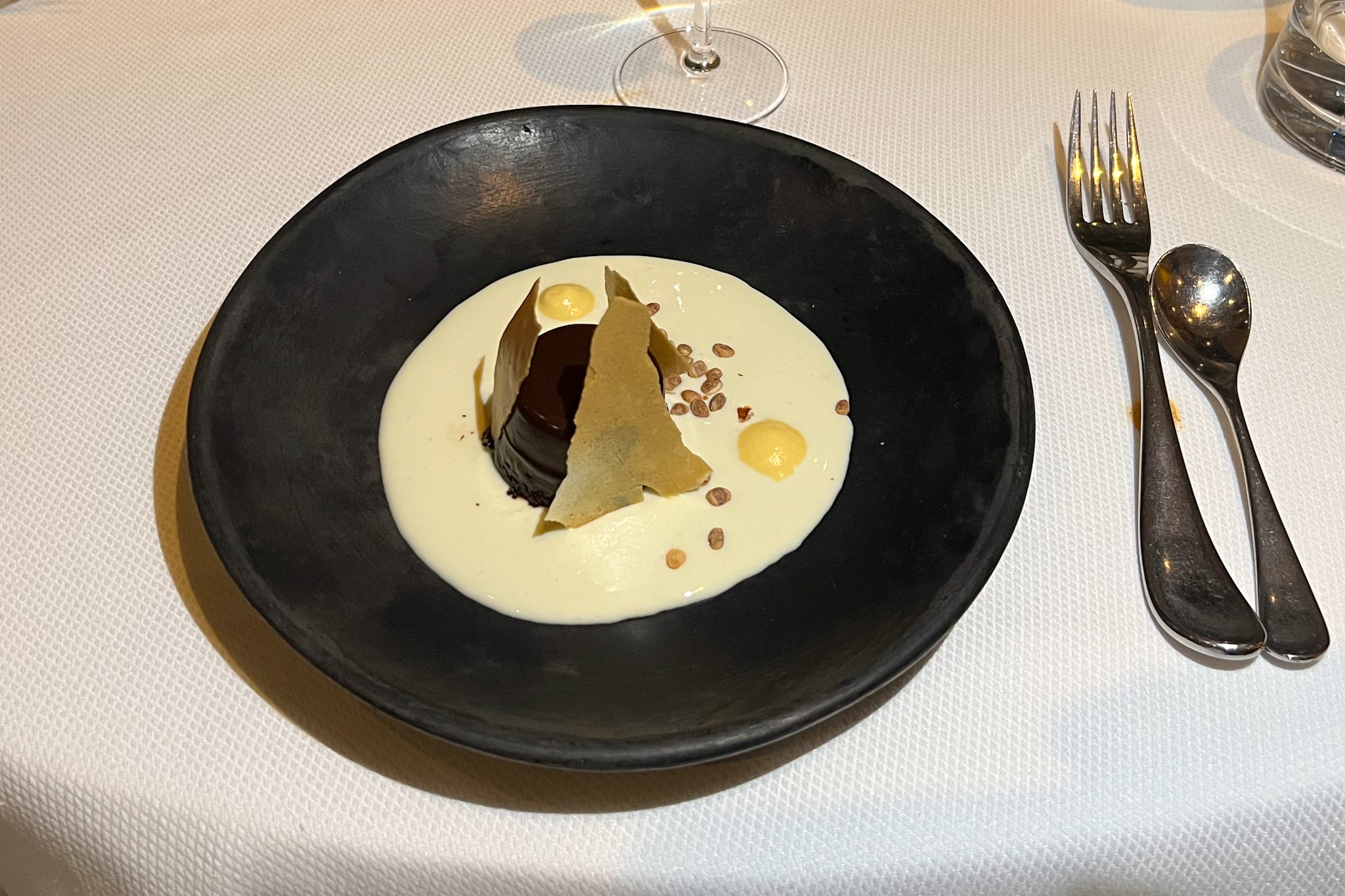
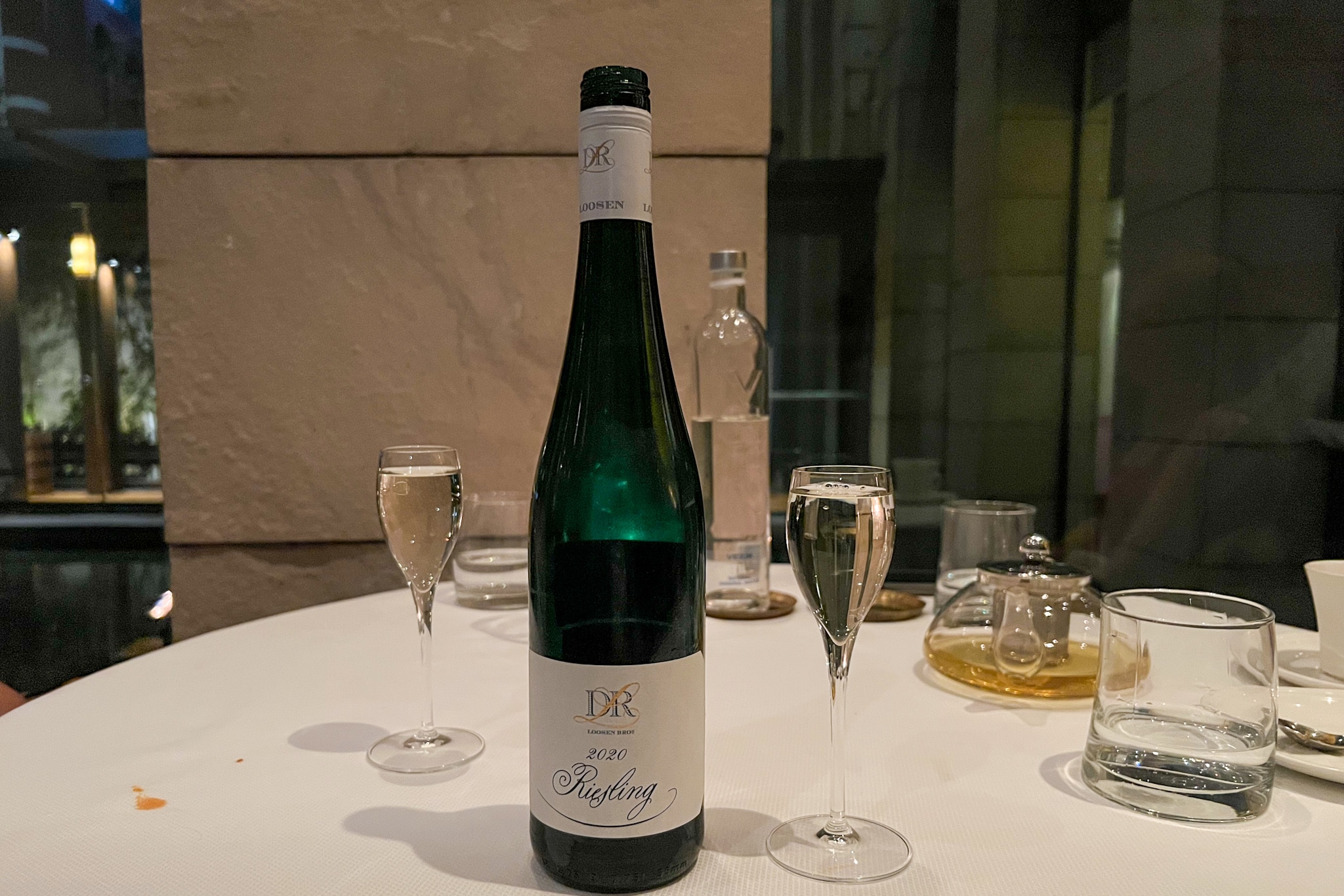
It was a rich way to finish the meal, and along with the separate desserts we ordered from the à la carte menu, made for a memorable ending to our evening.
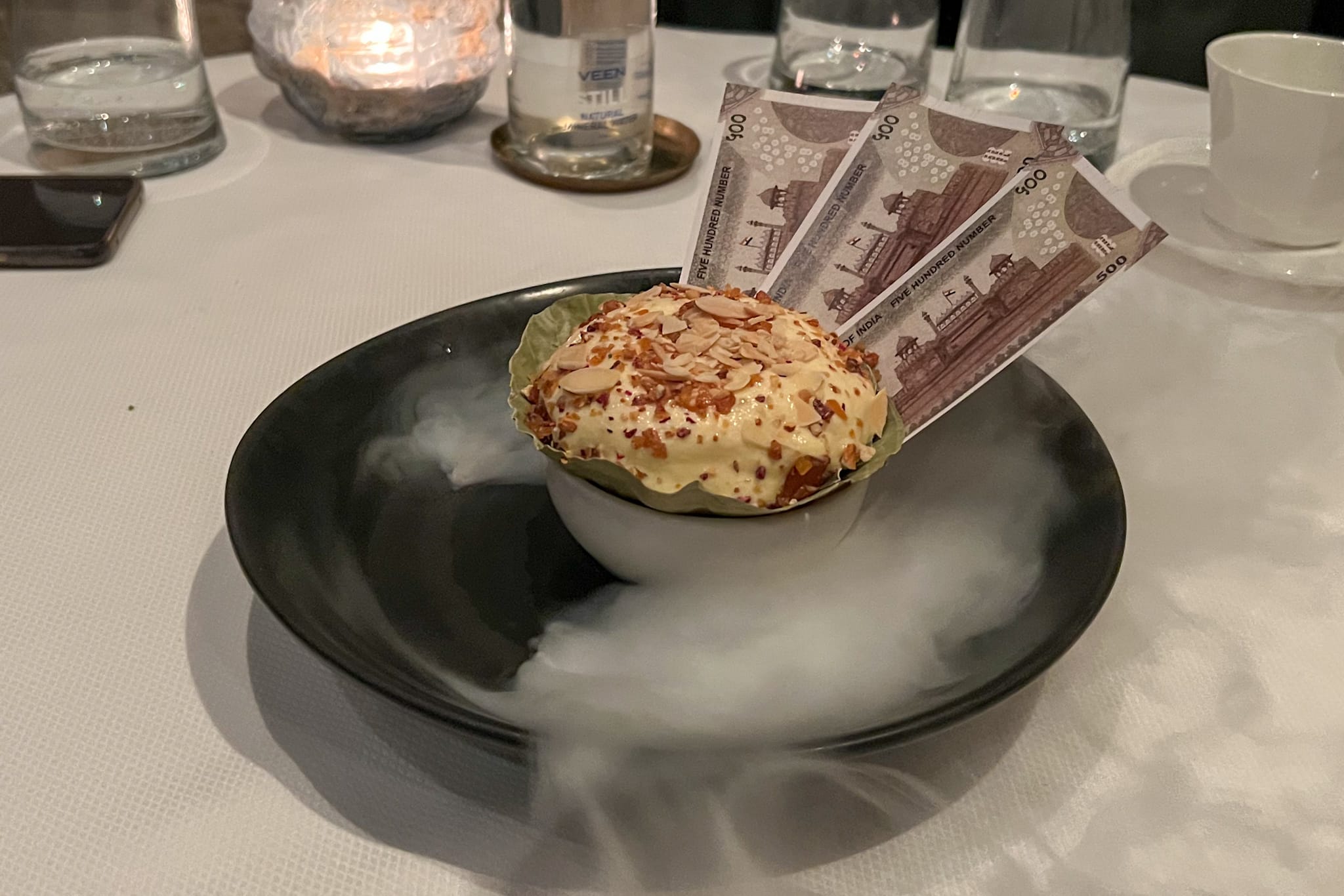
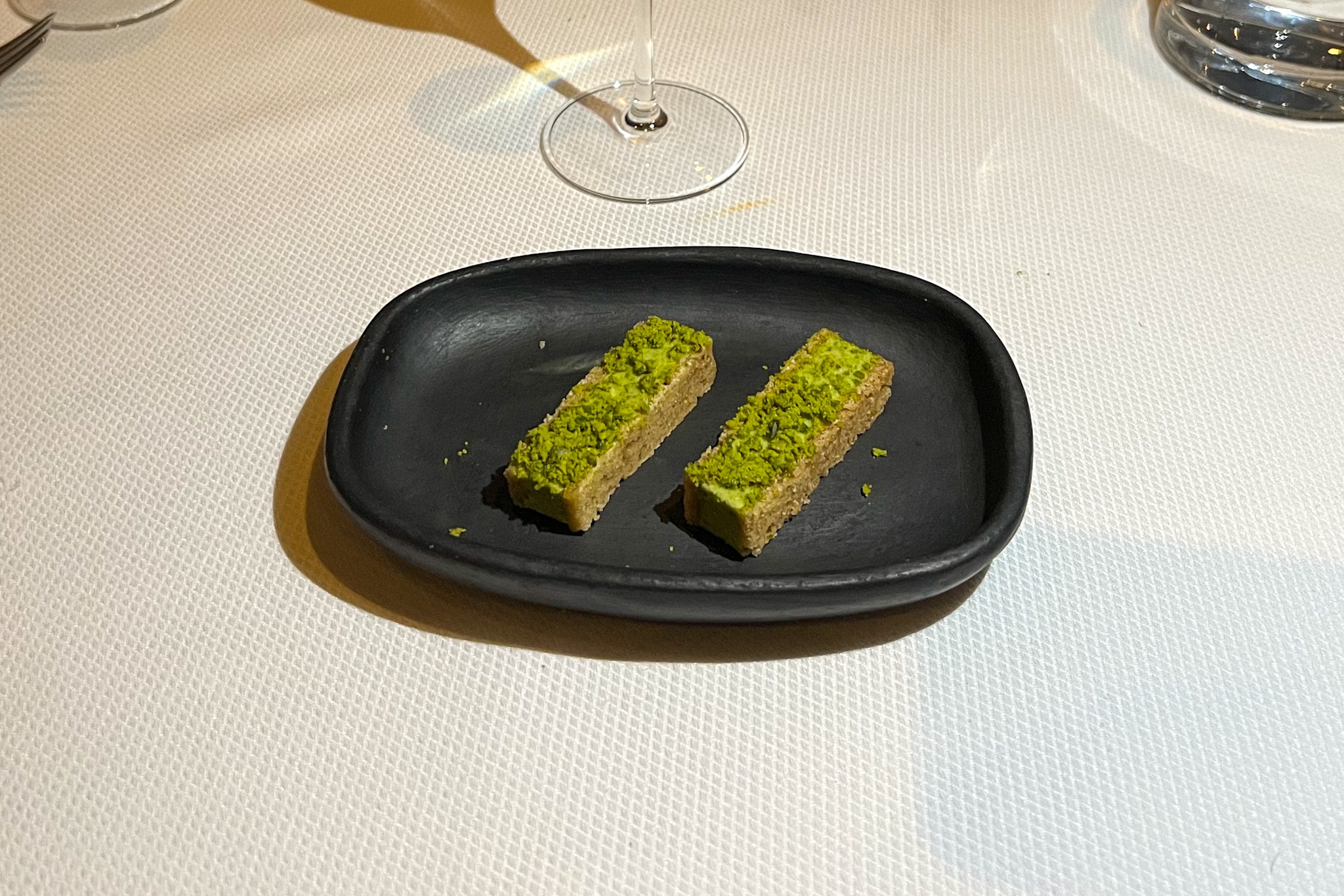
Indian Accent – Wine Pairings
I thought that opting for the wine pairings would be an excellent way to enjoy the full experience of what Indian Accent had to offer, but in the end, I wound up being a bit disappointed.
As you may have noticed in the menu prices, wine pairing costs almost the same price as the dinner itself. I was expecting this to be a top-tier pairing; however, as a trained sommelier myself, I was slightly disappointed that it didn’t meet my standards.
At no point did we feel that the wines paired with the dishes were an extraordinary match. They weren’t all that exciting on their own either, though I wouldn’t call the wines bad by any means.
While the staff were indeed trained in fine dining, the wine service was below what I’d consider a five-star experience. In fact, I didn’t notice any sommelier working anywhere in the lovely expanse of this restaurant.
Rather, our server would come and simply pour the wine, read from the label of the bottle, and then leave. I would have loved for an indication of why these particular wines were special, or what made them an exceptional pairing for each dish.
The order of the wine was a bit random as well. It’s customary to go from whites to reds during fine dining dinner experiences, or at the very least, it should move from lighter wines towards bolder ones.
During my experience at Indian Accent, it appeared to be more of a sporadic choice, beginning with rosé and then moving to white, and then onward to red and back to white, seemingly jumping all over the place.
My final note is in regard to the dessert, which was served with a German Riesling. As a sommelier myself, I found the pairing strange, but when I asked our server for the reason behind the pairing, I was told it was the only sweet wine they had.
For my next visit, I’d love to see more thought put into the wine pairings, especially for the price charged.
Indian Accent – Service
In my years, I’ve had the pleasure of enjoying many fine dining establishments, but I’d never had the opportunity to do so with Indian cuisine until now. This was what was most exciting to me about visiting Indian Accent, since I’ve always experienced Indian food in family-style meals with tons of food on the table for all to share.
It greatly impressed me to see it converted into this type of refined dining experience. Overall, the service was quite good, and the staff all came across as very friendly.
I’ve heard that the kind of staff hired for places like this must go through intensive training. This resulted in a very “white glove” or “classic” style of service, though it was less experiential.
I’m not sure if I’d have liked to see more storytelling behind this dinner, but the service still checked all the boxes for classic fine dining. The staff were busier behind-the-scenes, making sure everything was running smoothly, without being overly intrusive.
Overall, my experience with service and food at Indian Accent was positive. We had an enjoyable evening together and we’d likely do it all over again, except for perhaps skipping the wine pairing.
Conclusion
My first encounter with fine Indian dining presented the flavours I’ve come to love in a refined and unique way. We sincerely enjoyed the food at Indian Accent, and I still find myself thinking about the duck.
Chef Mehrotra really has some clever ideas on uniting the traditional tastes of Indian cuisine with different ingredients from other styles of cuisine.
As someone of Indian descent, I deeply enjoyed having those traditional foods prepared in a more modern manner. The fine dining atmosphere with Indian cuisine was something that was new to me.
I’d recommend Indian Accent to any traveller visiting New Delhi, and I’d agree that it lives up to the hype from all the awards and buzz surrounding it.
As for the wine, I’d recommend trying the tasting menu without the pairings, and opting to check the beverage menu to make your own selections. There are a number of options on that lengthy list that would have been better suited to the meal.



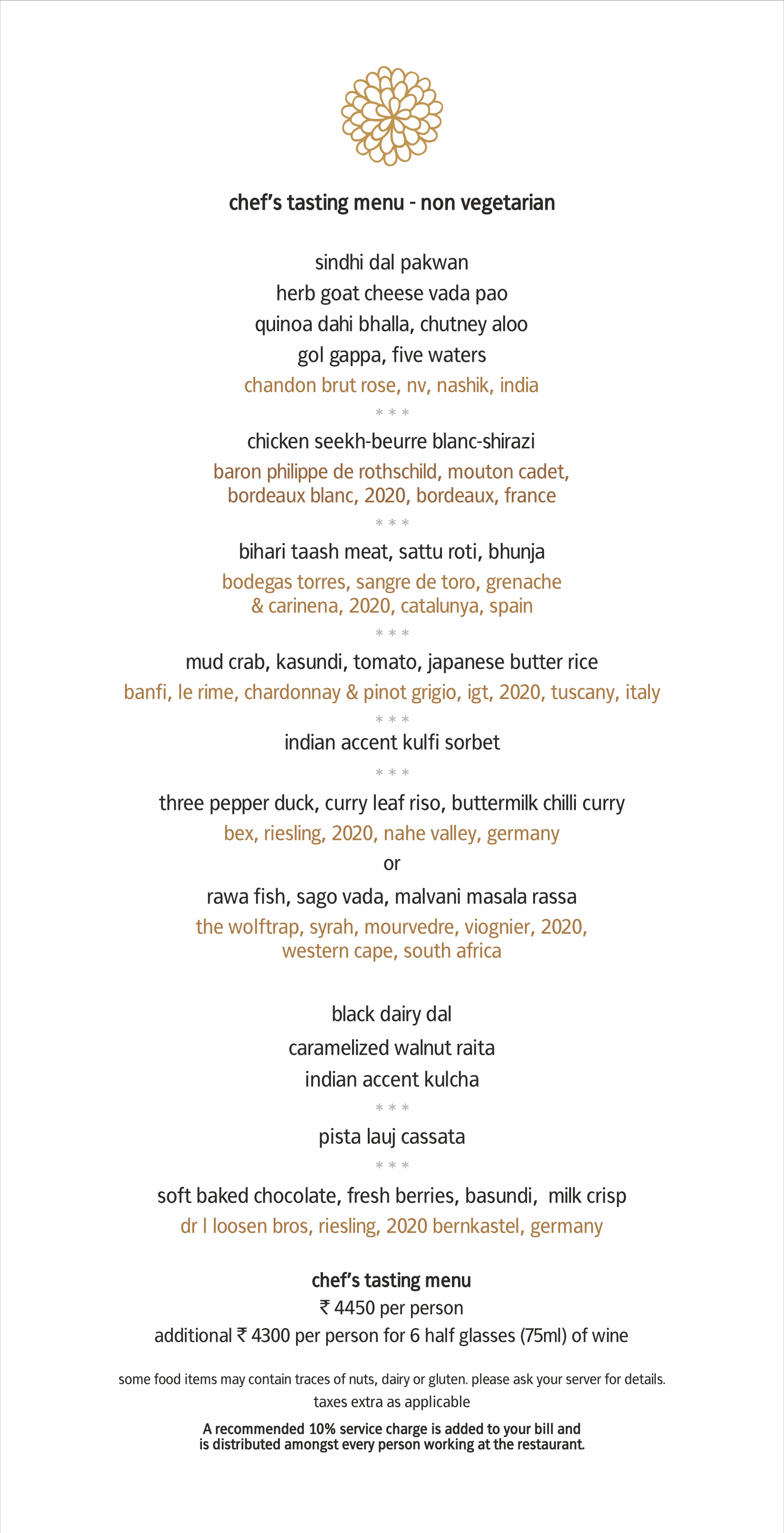
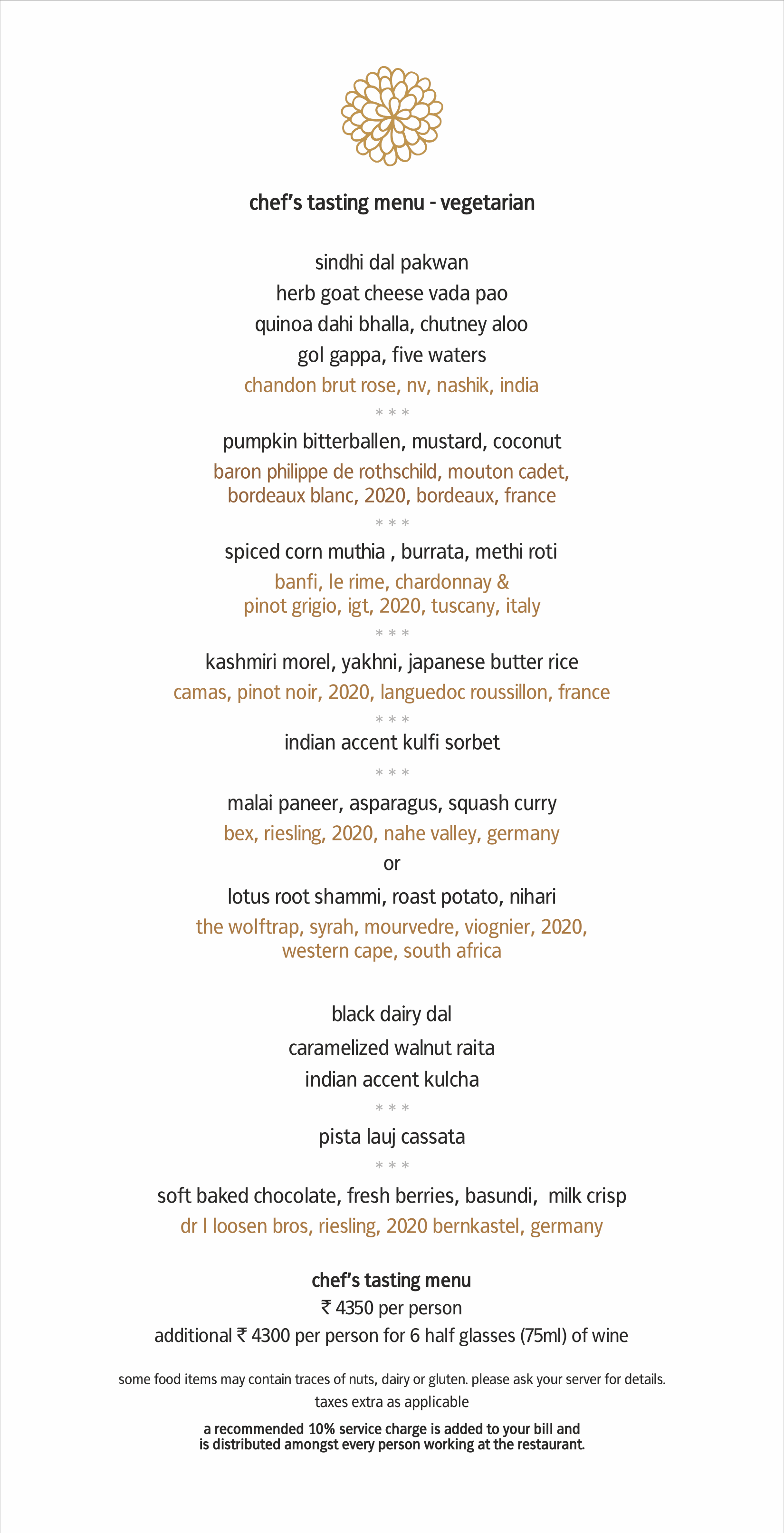
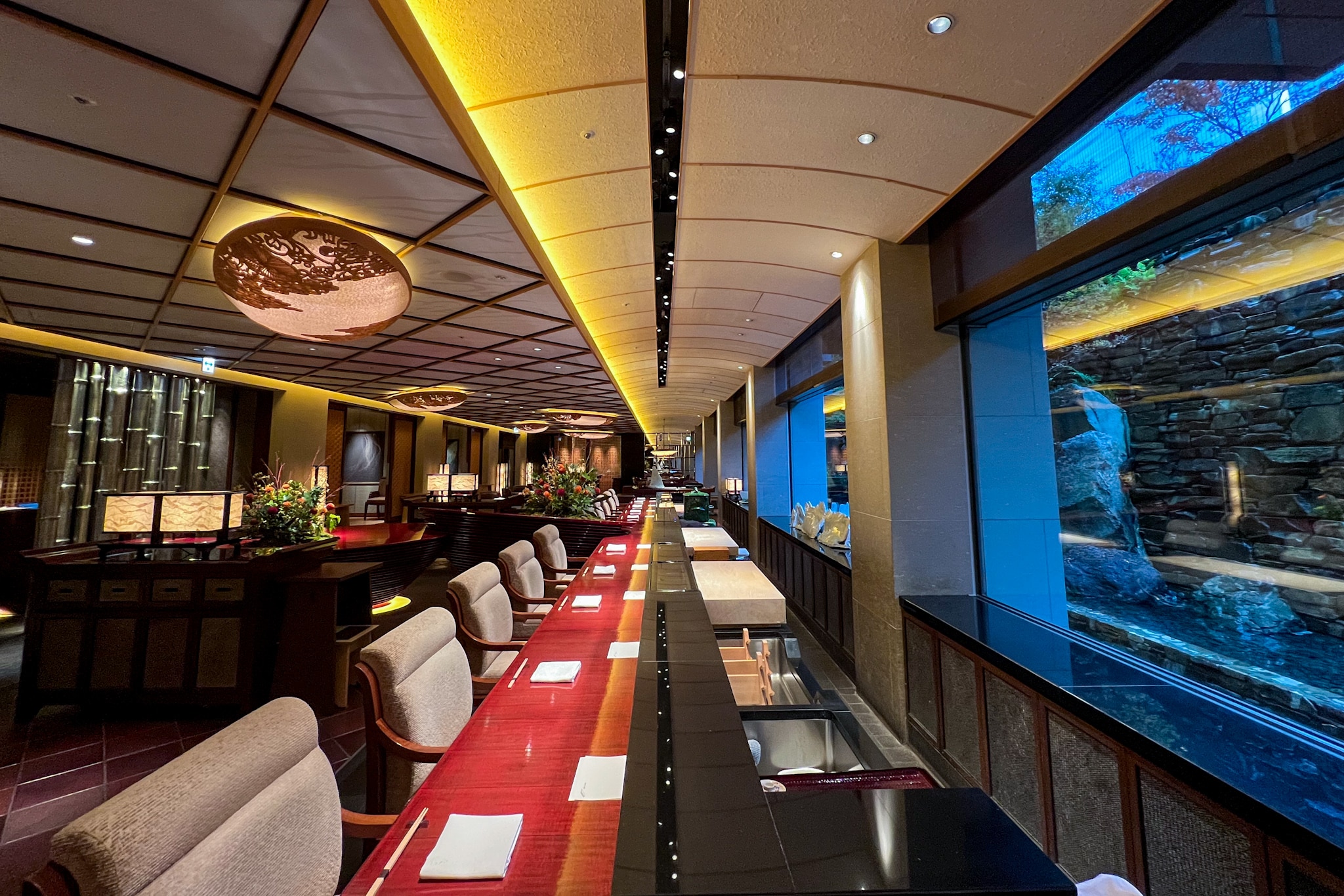
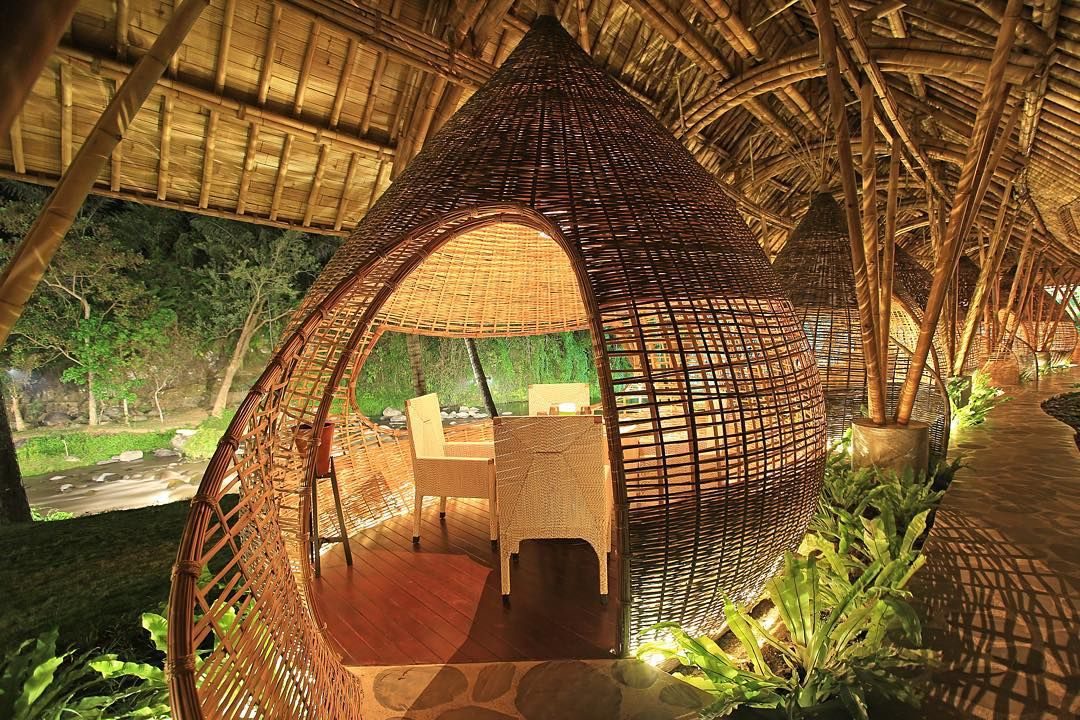
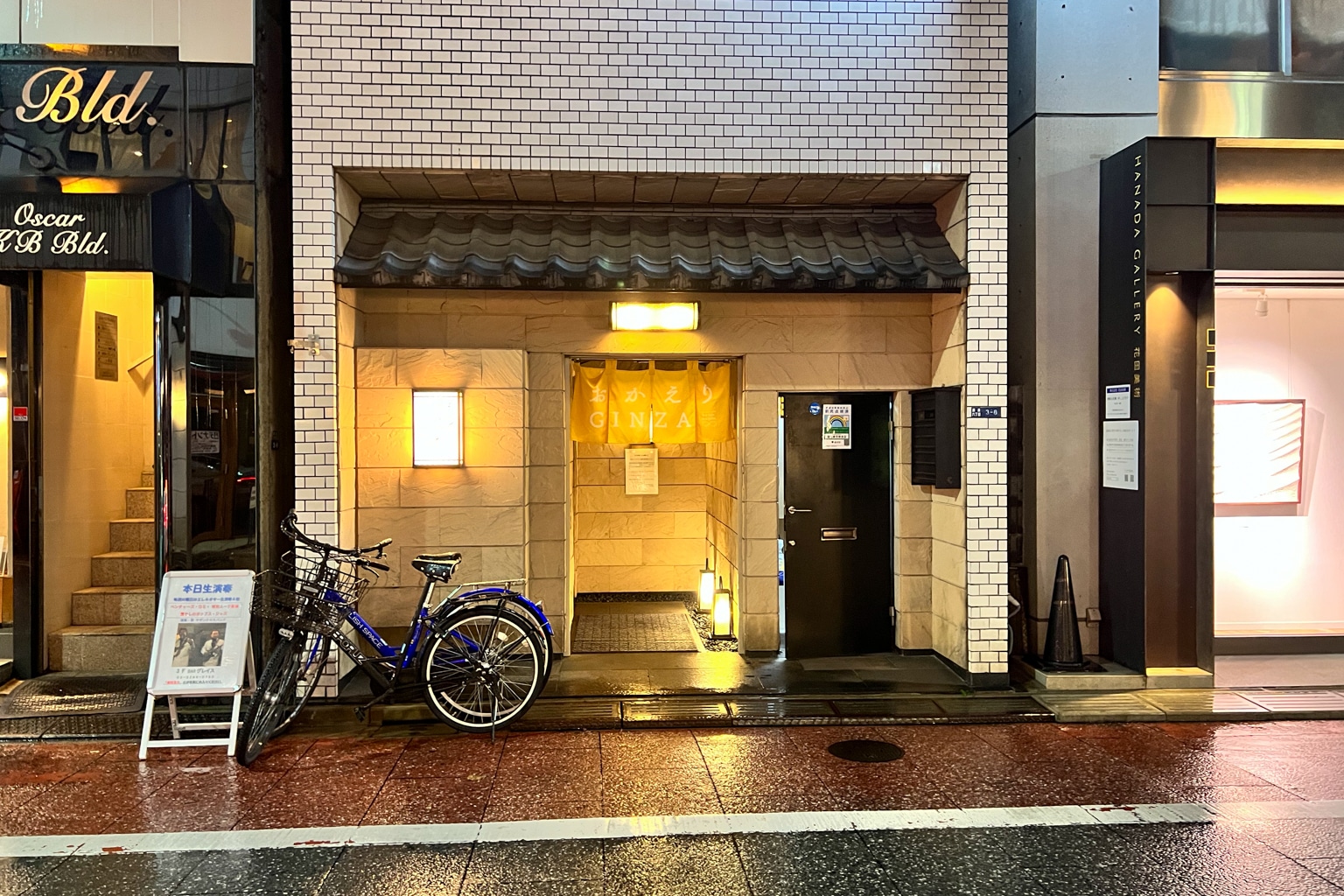

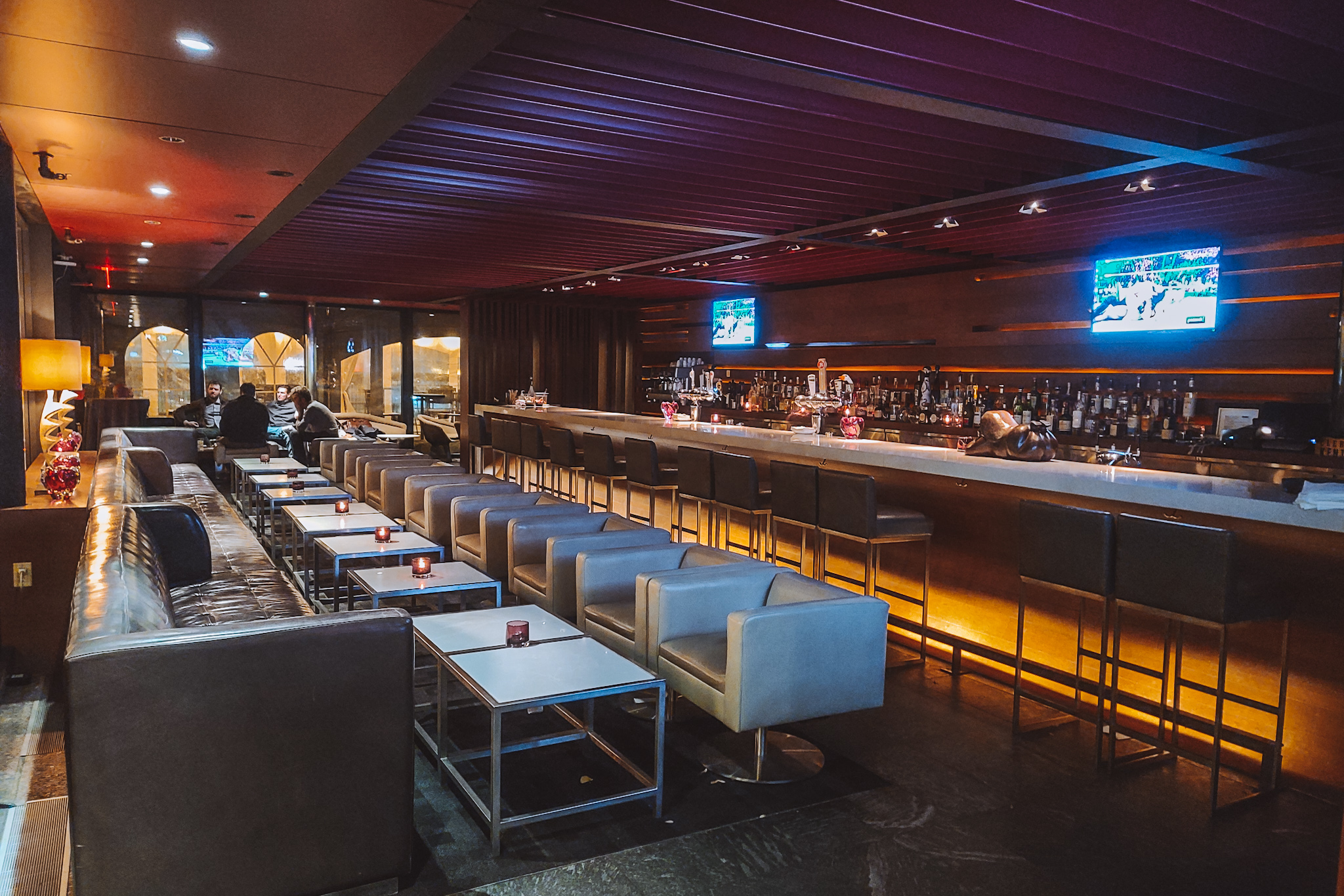
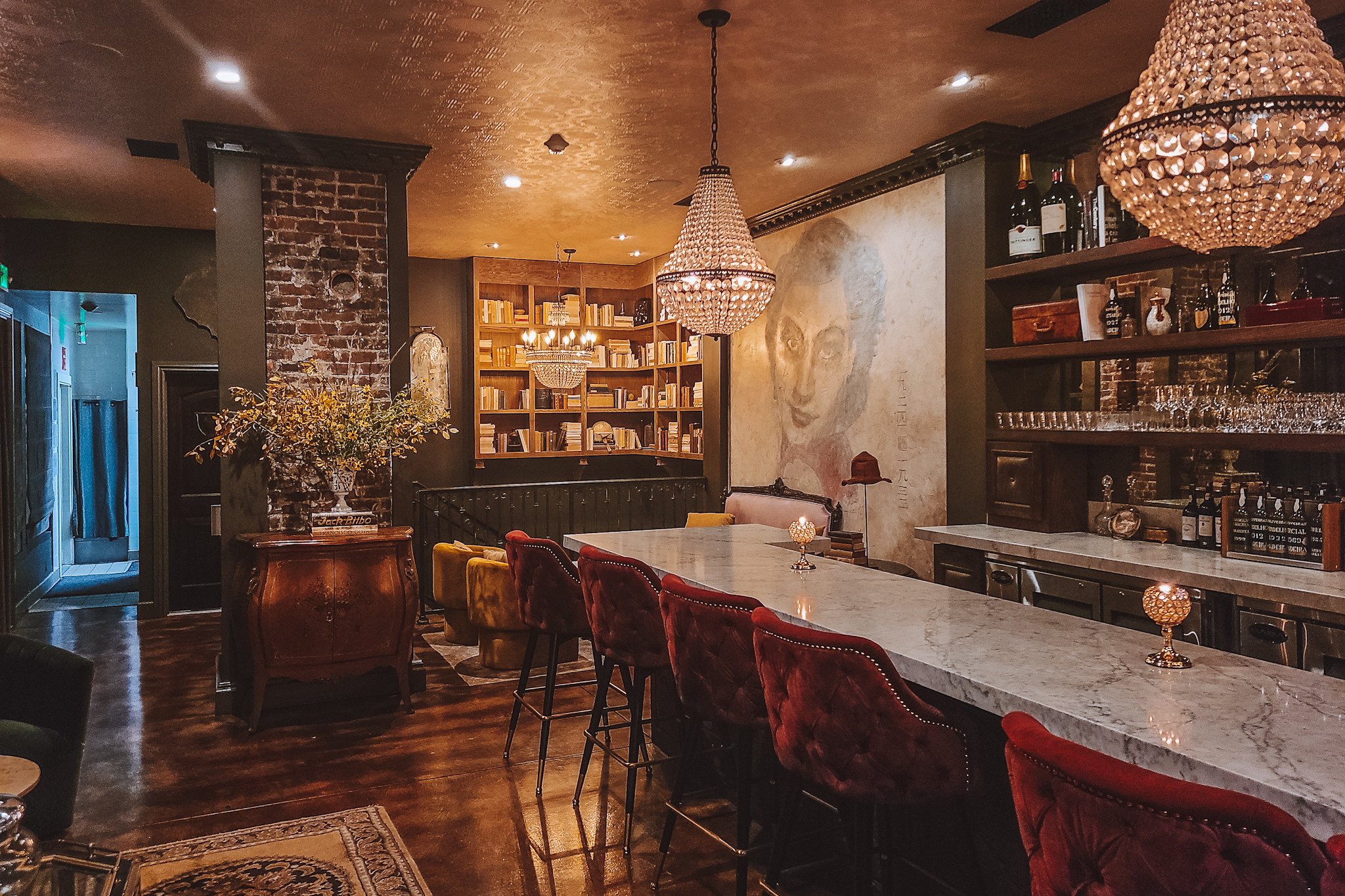













that bottle of Sangre de Toro wine is really low-end stuff. it costs only a few bucks in spain. hardly appropriate for this level of food. food looks delicious though.